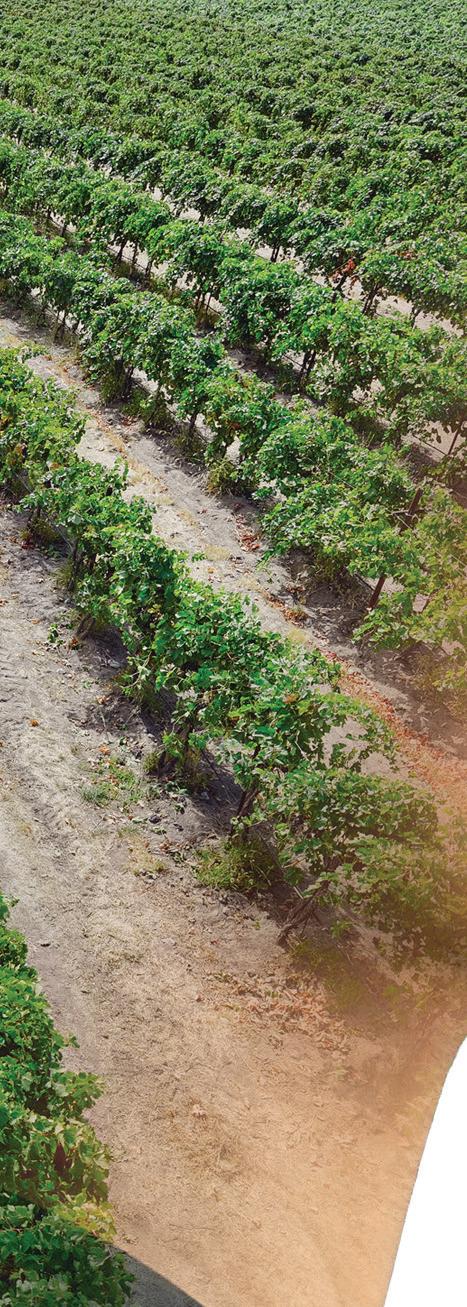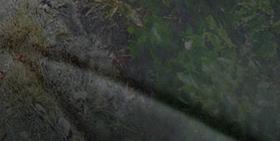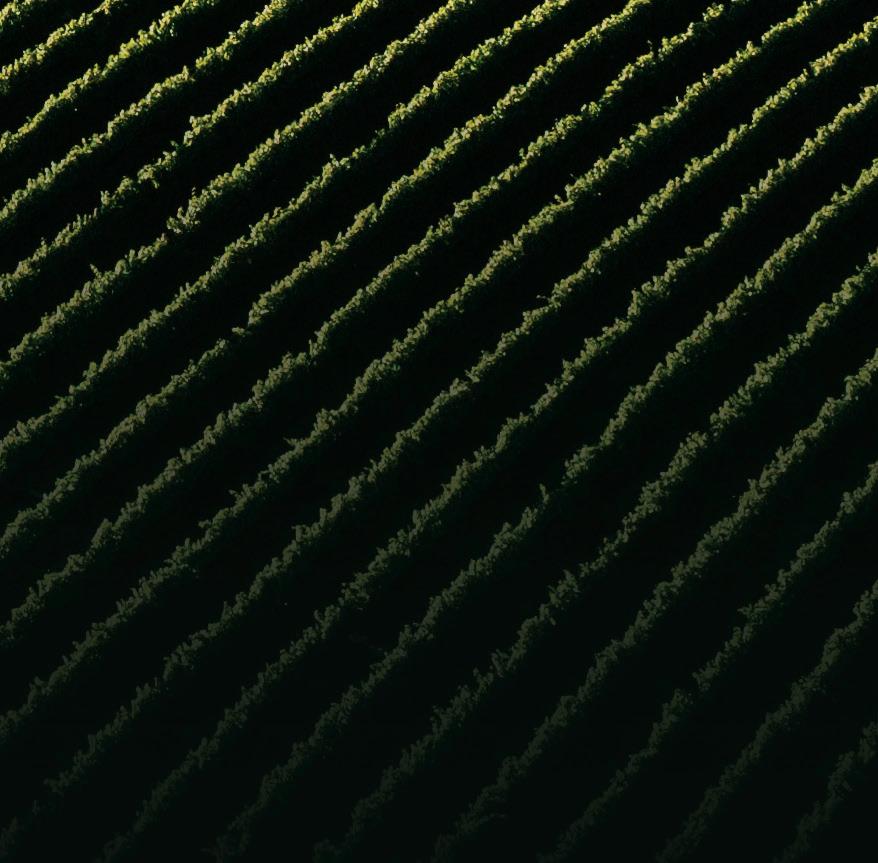












































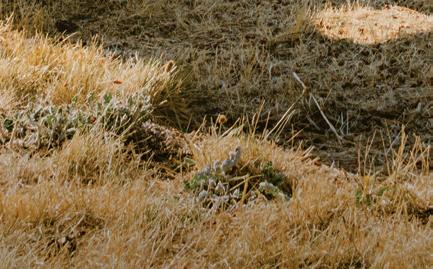
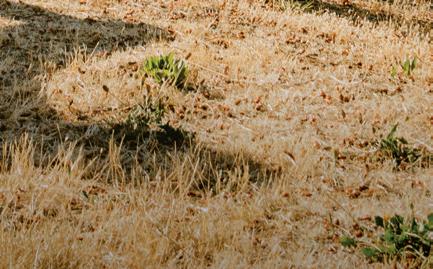
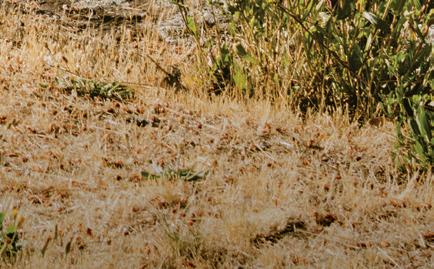




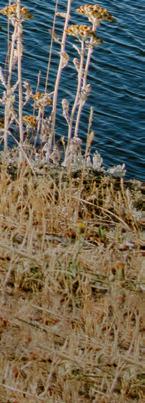


August to October 2025
























































August to October 2025
Ready for a getaway that’ll tickle your artistic fancy and let your inner adventurer do a happy dance? Pack your bags for a two-night romp in the mountain-hugged, art-sprinkled haven of Issaquah, Washington—where Lake Sammamish shimmers, the Issaquah Alps beckon, and serendipity is just a fifteen-minute zip from downtown Seattle.
Set your calendar for three days of wonder! Kick off with the third annual Issaquah Film Festival—where popcorn meets passion at the Hilton Garden Inn and Longman Performing Arts Center. Then, get ready for a curtain call at the 22nd annual Festival of New Musicals, courtesy of the legendary Village Theatre. On Saturday night, let your curiosity lead the way as you waltz through the Art Walk and Music Stroll, weaving between art and tunes in the historic Creative District.

Issaquah becomes the ultimate fishy catwalk in autumn—salmon strut their stuff, leaping and swirling in a spectacle that’s equal parts nature documentary and dance-off. For a front-row seat, plan your visit September 12-14 for the Salmon on Sunset Celebration, and don’t forget to stroll to the nearby quilt show—where threads and creativity collide, all within the charming Creative District.
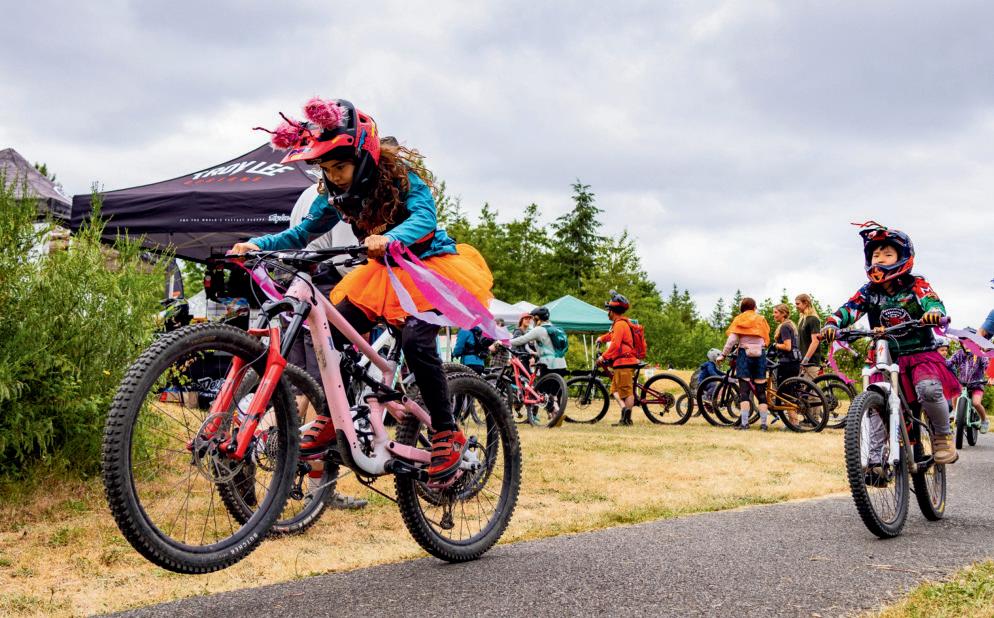
October 4 bring your littlest daredevils to the Take a Kid Mountain Biking Festival at Duthie Hill Mountain Bike Park. Issaquah’s legendary Salmon Days Festival takes over downtown October 4 & 5, with fish-themed fun and quirky crafts galore.




Feeling artsy? September 20th is your passport to atelier exploration! Wander the Issaquah Studio Tour, peeking into studios where artists conjure magic from canvas and clay. Wrap your adventure with a soul-soothing Sound Bath Experience at Lake Sammamish State Park, marking the autumn equinox with cosmic tranquility.

Between September 16 and October 19, fall head over heels for the enchanting romance of Brigadoon at Village Theatre. Grab your tickets at VillageTheatre.org and prepare for a musical journey that’ll sweep you right off your hiking boots.












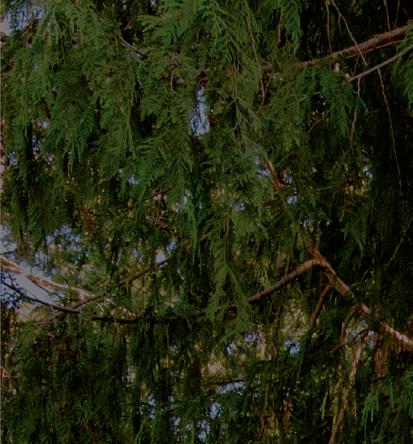




As climate-changing carbon levels in the atmosphere rise, could Washington’s forests be the answer?
wri en by Daniel O’Neil


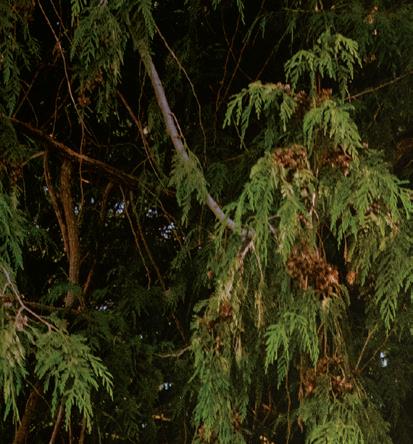
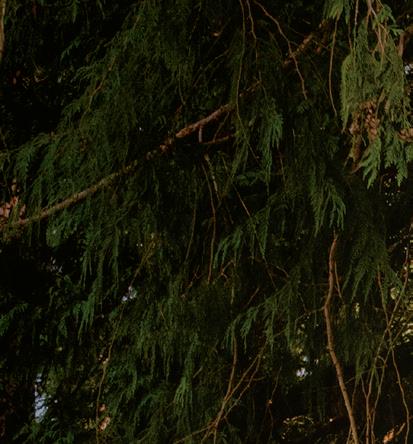

The San Juan Islands Museum of Art hosts Shapeshi ers, an exhibition showcasing contemporary Northwest Coast Indigenous art, now through September 15. Take a tour through our pages to see some of the works on view.
wri en by Kerry Newberry










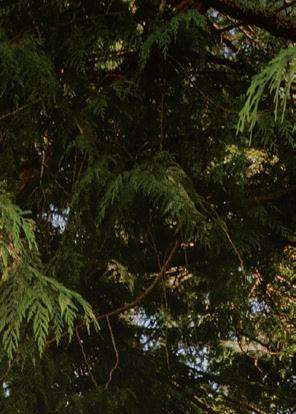

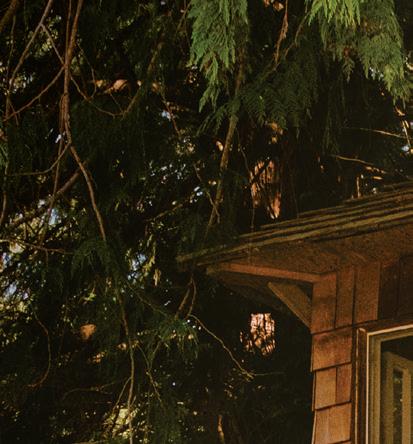






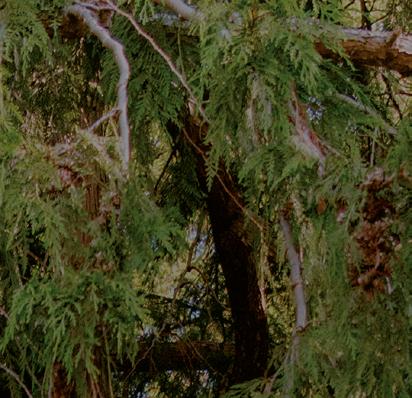





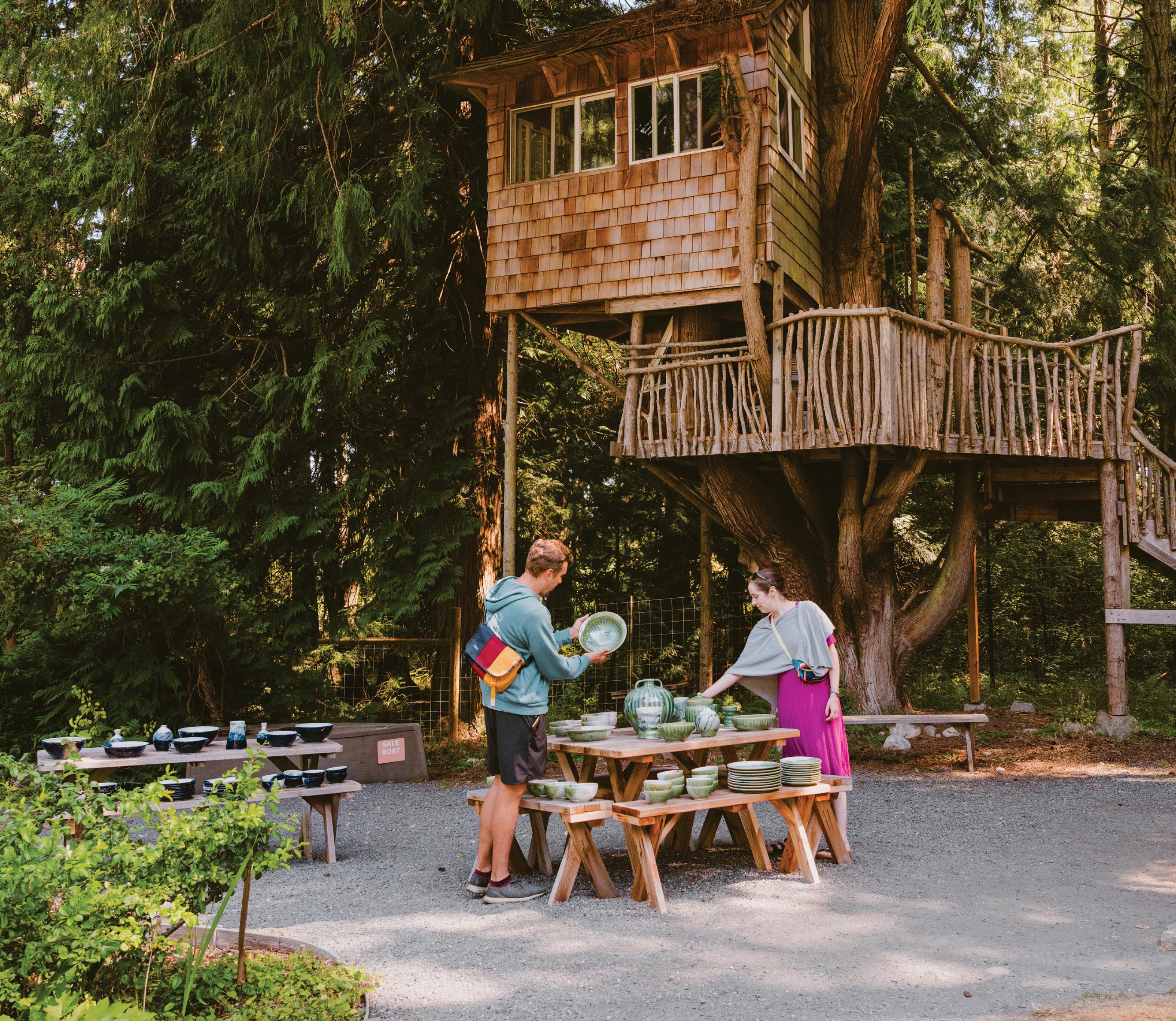

The San Juan Islands are teeming with creativity. Explore the artworks and culture of the islands, from galleries and studio tours to po ery and striking public art. wri en by Ryn Pfeu er




As an award-winning leader in small-ship cruising, UnCruise Adventures delivers unforgettable, all-inclusive voyages to the world’s most vibrant warm-weather destinations. Picture yourself aboard boutique vessels carrying just 22–86 guests: snorkeling in Baja’s crystalline Sea of Cortez, trekking through Costa Rica’s misty rainforests in search of scarlet macaws, tracking humpbacks
under Hawaiian sunsets, and even discovering Galápagos wildlife in timeless turquoise seas. Our all-inclusive fare wraps gourmet local dishes, handcrafted cocktails, expert-led excursions, and personalized service into every moment, making tropical exploration intimate, effortless and unforgettable.









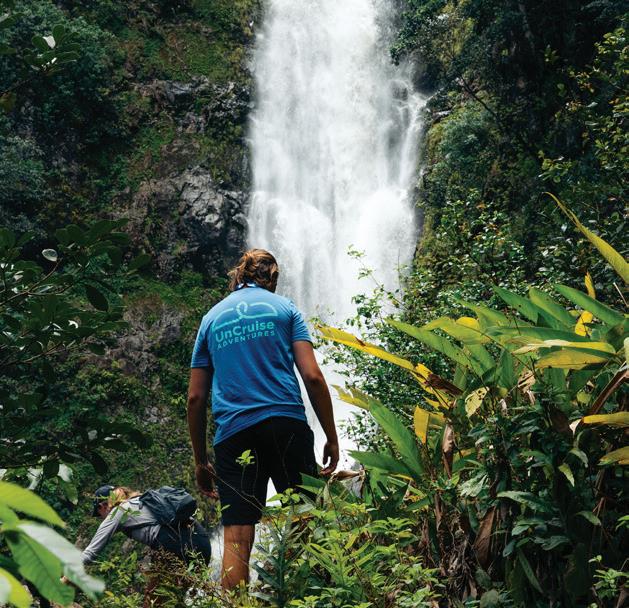




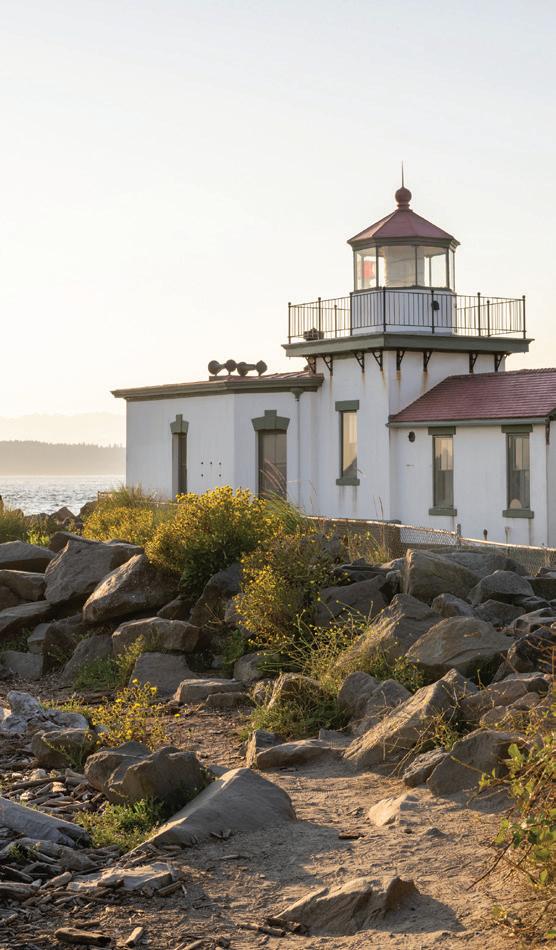
















(see “Where Creativity Meets the Current,” pg. 48)

Editor’s Le er Map of Washington Until Next Time 10 86 88
14 SAY WA?
The Sound of Music hits the stage in Leavenworth, Bremerton’s Blackberry Festival, a Pulitzer finalist.
18 FOOD + DRINK
No Boat Brewing Company, cra flour, Wenatchee’s Atlas Fare.
22 FARM TO TABLE
Washington-grown peas: tips and recipes.
28 HOME + DESIGN
A restaurateur from Sea le’s “first family of phở” brings her love of entertaining into her home remodel.
36 MIND + BODY
Figure skater Liam Kapeikis.
40 STARTUP
The Modern Dane’s eco-conscious linen bedding.
42 MY WORKSPACE
Bunny Dickson of Hama Hama Oyster Company.
46 GAME CHANGER
Nooksack Salmon Enhancement Association.
68 TRAVEL SPOTLIGHT
The otherworldly trails of Hoh Rain Forest.
69 ADVENTURE
Cultural adventures in glass, culinary, music and more.
72 LODGING
Warm Springs Inn, Wenatchee.
74 TRIP PLANNER
Experience September in Sea le.
82 NW DESTINATION
Victoria, B.C.











JENNA LECHNER
Illustrator
Home + Design DIY
“What I love most about being an illustrator is collaborating with others to make a shared vision come to life. I try to infuse a feeling of joy and wonder into all my illustrations, which often involve nature and handcrafts. If I can bring my love of dogs, basketry or food into an illustration (as I did with the illustration for the DIY in this issue), then that’s an added bonus!” (pg. 34)
Jenna Lechner is a freelance illustrator in Portland. Her ink and watercolor illustrations have appeared on stationery, wallpaper, packaging and more. You can see more of her work on Instagram @jennamlechner.

WILL AUSTIN Photographer
Farm to Table
“Whidbey Island is my favorite location in Western Washington, so I was very excited to visit Rowdy Sprout Farm. Although I have photographed many ranches over the years, this was my first farm shoot. Kirsten and Tommy were wonderful hosts, and, naturally, I couldn’t resist sampling their delectable produce as I worked.” (pg. 22)
Will Austin’s award-winning photographic work has taken him around the world. Whether shooting from a saddle, a helicopter seat or the dizzying height of a tower crane, Austin enjoys the adventure of capturing people doing what they love. He lives in the Seattle area with his wife and son but hails from Colorado cowboy country.
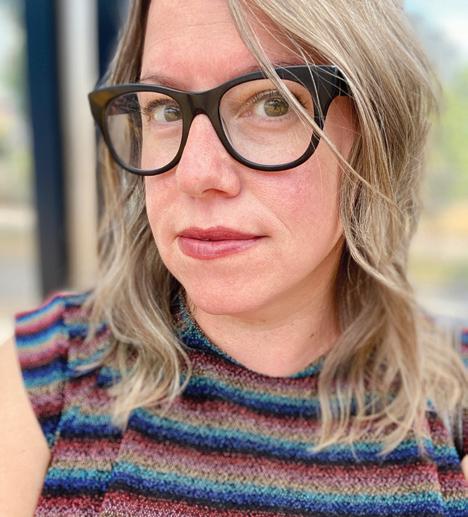
RYN PFEUFFER Writer
Where Creativity Meets the Current
“I’ve been captivated by the San Juan Islands for nearly twenty years, and what keeps drawing me back is their stunning natural beauty and rich cultural heritage. I love how the land, sea and Coast Salish traditions inspire the local art and food—that sense of connection is everywhere. With so many passionate artists and community events, I see the islands as a living tapestry of history, creativity and community.” (pg. 48)
Ryn Pfeuffer’s work has appeared in AFAR, Business Insider, Cruise Critic, Men’s Health, National Geographic Traveler, The Seattle Times and Travel + Leisure. She lives on Whidbey Island with her partner and rescue puppy.

MELISSA DALTON
Writer
Home + Design
“I’ve worked on my own house remodel in Portland for many years and, throughout it, strived to balance function and personal meaning in every room. It was a joy to talk to Quynh-Vy Pham, a restaurateur from Seattle’s ‘first family of phở,’ about how she and SHED Architecture & Design achieved that balance in her own home. Plus, they used a lot of pink.” (pg. 28)
Melissa Dalton is a freelance design and architecture writer who covers a wide range of stories, from A-frames to passive homes, historic restorations and DIY projects. She lets her curiosity guide her life and writing.
EDITOR Kevin Max
CREATIVE DIRECTOR Allison Bye
WEB MANAGER Aaron Opsahl
SOCIAL MEDIA MANAGER Joni Kabana
OFFICE MANAGER Cindy Miskowiec
DIRECTOR OF SALES Jenny Kamprath
BEERVANA COLUMNIST Jackie Dodd
C ONTRIBUTING WRITERS Cathy Carroll, Melissa Dalton, Rachel Gallaher, Joni Kabana, Lauren Kramer, Kerry Newberry, Daniel O’Neil, Ryn Pfeuffer, Ben Salmon, Corinne Whiting
CONTRIBUTING PHOTOGRAPHERS Will Austin, Jackie Dodd, James Harnois, Mac Holt, Jon Jonckers, Rafael Soldi
CONTRIBUTING ARTISTS Jenna Lechner
Mail Headquarters
70 SW Century Dr. Suite 100-218 Bend, Oregon 97702
www.1889mag.com /subscribe @1889washington
592 N. Sisters Park Ct. Suite B Sisters, OR 97759
All rights reserved. No part of this publiCation may be reproduCed or transmitted in any form or by any means, eleCtroniCally or meChaniCally, inCluding photoCopy, reCording or any information storage and retrieval system, without the express written permission of Statehood Media. ArtiCles and photographs appearing in 1889 Washington’s Magazine may not be reproduCed in whole or in part without the express written Consent of the publisher. 1889 Washington’s Magazine and Statehood Media are not responsible for the return of unsoliCited materials. The views and opinions expressed in these artiCles are not neCessarily those of 1889 Washington’s Magazine, Statehood Media or its employees, staff or management.
IF WASHINGTON were a painting, oysters would be well represented on it. On page 42, we go behind the curtain at one of Washington’s iconic oyster farms, Hama Hama, but through the eyes of one of its mission-driven workers. Turn to My Workspace to learn how Bunny Dickson left San Francisco to follow her heart and conscience.
Late summer and early fall are the sweet spots for art festivals across the state. In this issue, we bring you a mini guide to art festivals and experiences in the San Juan Islands—from woven arts on San Juan Island to paintings and kinetic sculptures on Orcas Island, local art and artists are a great way to make a lasting connection and support artists. Turn to page 48.
While on San Juan Island, don’t miss the Shapeshifters exhibit at the San Juan Islands Museum of Art. Through September 15, explore contemporary Northwest Indigenous art through the lens of transformation, featuring the work of artists from Washington and British Columbia (pg. 62).
In “Growing Carbon” on page 56, join the debate about what we can best do for carbon reduction and storage to help mitigate the effects of global warming. One study of Washington’s west-side forests calculated that these trees currently hold nearly 830 million metric tons of carbon, the equivalent of 8.3 million train carloads of coal. What can we do to preserve these trees as a carbon sink?
In this issue, we see Seattle with new eyes for our Trip Planner (pg. 74). Maybe it’s the drawdown of summer visitors. Maybe it’s the cooling into fall to hop on a harbor cruise. Maybe it’s the prevalence of cool music events. Maybe it’s the discovery of a new menu from a favorite chef. Maybe it’s a bit of all of that. Make your plan to dive back into Seattle in September, when the Emerald City is at its best.
If you find something to celebrate, even if it’s just yourself, try this ingenious cocktail from the 108 Lounge—the champagne margarita (pg. 19). It is exactly what it sounds like and the antidote for a warm summer’s eve.








SAY WA? 14
FOOD + DRINK 18

FARM TO TABLE 22
HOME + DESIGN 28
MIND + BODY 36























Mount Rainier National Park is a place of transformation, where snowmelt fuels powerful waterfalls, and hiking trails reveal their vibrant beauty. Discover iconic cascades like the 72-foot-high Myrtle Falls, the Narada Falls, and the Christine Falls, with their rushing waters framed by lush greenery and dramatic rock formations. Each trail offers a chance to get close to the action, with the sound of waterfalls creating a backdrop for an unforgettable adventure. As you hike, look for blooming avalanche lilies along the trails, their bright white petals adding to the breathtaking scenery. The trails are alive with fresh air, stunning views, and the promise of discovery around every corner. Whether you’re chasing waterfalls or enjoying a peaceful walk, join us for an adventure that will leave you inspired and connected to the beauty of Mount Rainier.











written by Lauren Kramer

In August, Leavenworth’s hills come alive with The Sound of Music, as it continues its annual tradition at Leavenworth’s Ski Hill Amphitheater. Eleven performances are scheduled between August 2 and 30, bringing the endearing story of Maria von Trapp and her family to audiences at sunset.
www.leavenworthsummertheater.org/som

If you love the winelands, consider exploring them on an e-bike tour. Chelan Electric Bikes offers a back roads and winery tour of Manson where guests cycle 15 miles of country roads, stopping for tastings at three wineries along the way. The quiet back roads are dotted with magnificent lake and mountain views, and the four-hour experience is a pleasant, easy one where little exertion is required. The tours run through October.
www.chelanelectricbikes.com
Walla Walla Fair and Frontier Days


Walla Walla Fair and Frontier Days, Washington’s oldest fair, is August 27 through 31 and features demolition derbies, carnival rides, the PRCA rodeo and a performance by Foreigner, a 2024 Rock & Roll Hall of Fame inductee. Tickets start at $12.
www.wallawalla fairgrounds.com


The Side Street Cashmere
Imagine a dilapidated, old fruit-packing warehouse reincarnated into a vibrant, communityfocused gathering spot and filled with an eclectic mix of interesting retail and dining options. That’s The Side Street in Cashmere, where a clothing and home decor boutique rubs shoulders with a secondhand bookstore, an arts and crafts supply store, a coffee shop, a cider shop and a venue for repurposed home building supplies.
www.sidestreet cashmere.com
Fort Vancouver Bicentennial Celebration
Absorb some state history at Fort Vancouver National Historic Site on its 200th anniversary.
On August 16, entrance fees are waived, and visitors can participate in guided walks, demonstrations by costumed interpreters and music reminiscent of that period.
www.bit.ly/ fortvancouver bicentennial

Bremerton’s Blackberry Festival, August 30 to September 1, is an annual celebration held on the Bremerton boardwalk and 2nd Street. This fun event, a fundraiser for the Bremerton Rotary Foundation, includes 150+ vendors, bands, beer, blackberry wine and live music.


www.blackberryfestival.org
written by Ben Salmon

RACYNE PARKER is still figuring things out—just like you and me and everyone else.
Originally from Klamath Falls, Oregon, the 30-year-old singer-songwriter grew up around music. Her father played in local bands, and when she could, she’d sing alongside him at his gigs. She began writing songs “as a little bitty kid,” she said, and started playing guitar in the fifth grade.
“I knew (music) was something I always wanted to do, but chasing that dream has a lot of stigma associated with it,” she said. “I was pretty afraid to do it for a long time.”
As a teenager, Parker turned her focus away from music and toward sports, and she then went to Willamette University to study biology and prepare for medical school. But while in college, she rediscovered songwriting (“For real” this time, she said) and started playing out in public around town. at’s what felt right to her, but still, she was unsure.
“With some careers, there’s a ‘to-do’ list. You check things off : Get good grades. Go to college. Apply for a job,’” Parker said. “ ere’s a right path. And music feels like this very unclear and uncertain path.”
After graduation, though, she had accumulated some good songs, and her dad encouraged her to record them. At the same time, she started playing more gigs, and she was having a blast during them. She had an opportunity to relocate to Denver, and she decided to try to hit the ground running there—as a musician.
“I was like, ‘I’m going to move there. I’m going to go to everybody’s shows. I’m going to meet everybody. I’m going to start playing out,’” she said. “But it was March of 2020, so those
plans got put on hold (by the COVID-19 pandemic).”
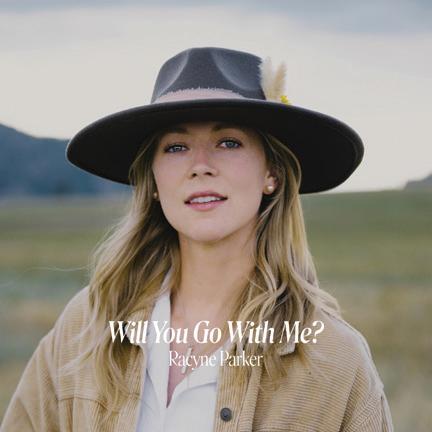


Over the next five years, though, Parker’s plan unfolded just a little more slowly than expected. She did meet people, and she did play gigs, and she also wrote a bunch of songs that would eventually become her debut full-length album, Will You Go With Me?
Primarily recorded with Randall Kent at Deaf Dog Studios in Nashville, it’s an eleven-track collection of well-crafted and ultra-catchy Americana music that lives somewhere near the midpoint between Kacey Musgraves’ searching, starlit twang-pop and Miranda Lambert’s tough-talkin’ traditional country.
“ e whole theme of the record for me is just me trying to figure it out and asking people if they’ll come along with me as I do that, because I don’t want to do it alone,” Parker said. “It’s like, ‘I want to do this, and I hope somebody will do it with me.’ I was living that feeling for years, so I just wrote songs about it.”
About a year ago, Parker moved again, this time to Seattle, where she feels like she’s “starting over in a lot of ways,” she said. She took a step back from constant gigging and is focusing on playing meaningful shows—“saying ‘yes’ to things that are exciting,” she said. She’s also pursuing a lifelong interest by working part time at a bakery while she gets a band together and works to build community in her new city.
And she knows music will be there for her, always.
“Some days, I’m like, ‘I was born to do this and I’m going to do it no matter what.’ And other days, I’m like, ‘Well, that’s kind of crazy,’” Parker said. “But when I come back to it, I know I’m going to be making music regardless of who hears it. Forever.”

and Intertwining Cultures
A Sea le Pulitzer finalist discusses dialogue, tangents and her conceptual sandbox
interview by Cathy Carroll
THE NOVEL Mice 1961 by Sea le’s Stacey Levine was one of three finalists for this year’s Pulitzer Prize in fiction. Set in southern Florida at the height of the Cold War, it centers on two orphaned half-sisters, a boarder and the neighbors who orbit their world. The Pulitzer Prize jury lauded the book as “a stylized and startling depiction of lives lived at a high pitch of emotion in the shadow of global catastrophe.”
The story unfolds on a single day, tracing the charged relationship of the two sisters, as seen through the eyes of their obsessively observant lodger. A Greek chorus of neighborhood characters cavort and joke through a local party, and the arrival of an unse ling stranger spurs the three women toward momentous change.
Levine, who teaches creative writing and English composition at Sea le Central College, has earned many accolades for her other voice-driven works. Her short fiction collections include My Horse and Other Stories, which won a PEN Fiction Award, and The Girl with Brown Fur, which was shortlisted for the Washington State Book Award, as was her novel Frances Johnson
What inspires the sound and style of dialogue in your fiction?
I’ve been inspired by Jane Bowles, David Mamet and Brazilian author Clarice Lispector. I think it’s worth noting that most dialogue in fiction is not really how people literally speak. Real conversation is filled with uh, oh, wait, umm, whatchamacallit and lots of backtracking and physical gestures. So dialogue in most books, while we might call it realism, isn’t realistic. For this reason, I’m sometimes interested in recording actual phrases that people speak, which don’t always make clear sense or which sound comical. I’m also interested in creating characters that say exactly what they feel or think with no censors. That results in funny and brutally direct conversations.


by The Brooklyn Rail. They have really deep thinking interviewers. I guess when we’re first discovering creative writing, there’s a realization about how much life we can explore through a fictional lens. And that can be really breathtaking. Yes, I remember while I was working on my novel Mice 1961, still in the middle of it with so much more work to go, I did grow really excited about the book’s potential to the extent that I kind of felt sick! In other words, it was a li le overwhelming.
In an interview with The Brooklyn Rail, you described going o on descriptive tangents during a night class in essay writing and discovering a sensation you couldn’t let go. Do you still experience that when you write today?
Thanks for mentioning the interview questions put to me
Tell us how and why Florida—so di erent from the Northwest—became a “conceptual sandbox” for two of your novels so far. I think this is because I visited South Florida several times in my formative years and the culture seemed so out-there and cray to me, a separate location outside the bounds of my life and world. But if my creative/conceptual playspace hadn’t been south Florida, I’m positive it would have been some other place. Many novelists have favorite or repeated se ings or themes in their books which they o en return to.

written and photographed by Jackie Dodd
TUCKED JUST OFF Interstate 90 in Snoqualmie, a few miles from the trailheads of Rattlesnake Ridge and the base of Mount Si, No Boat Brewing Company is an unassuming but beloved outpost in the Northwest beer scene. Founded in 2016 by the Skiba family—David, Gary and Mary—the brewery quickly became a community fixture, known as much for its thoughtful beer as for its welcoming taproom and expansive outdoor space. With a name like No Boat, head brewer and co-founder David Skiba is asked more often than he’d like to count if he does, in fact, have a boat. He does not—and at this point, even if he wanted one, it probably wouldn’t happen purely out of exhaustion from having to explain it.
From the outside, No Boat doesn’t look like much. Located in a converted industrial building near a strip of auto shops and landscaping suppliers, it’s not a place you’re likely to stumble upon—it’s a destination you seek out. Follow the trail of hikers, dogs, strollers and wandering beer lovers past the parking lot-turned-beer garden, through the roll-up garage doors, and you’ll find a taproom with all the right elements: long tables for lingering conversations, a wall of rotating taps, staff who know your name (or, more likely, your dog’s name) and just enough fermentation tanks in the background to remind you this is where the magic happens. The space is massive, with more than enough room to host events—like the annual Lagerhead Fest, which benefits the conservation charity Washington Wild—as well as ample square footage to expand as they grow.
Skiba came to beer by way of wine. After working in the wine industry in both California and Washington, he shifted his focus to brewing, a background that helps explain No Boat’s balance between traditional brewing styles and more nuanced experimentation. On any given week, the tap list might include a crisp lager, a hop-forward pale, a dark and malty seasonal release or
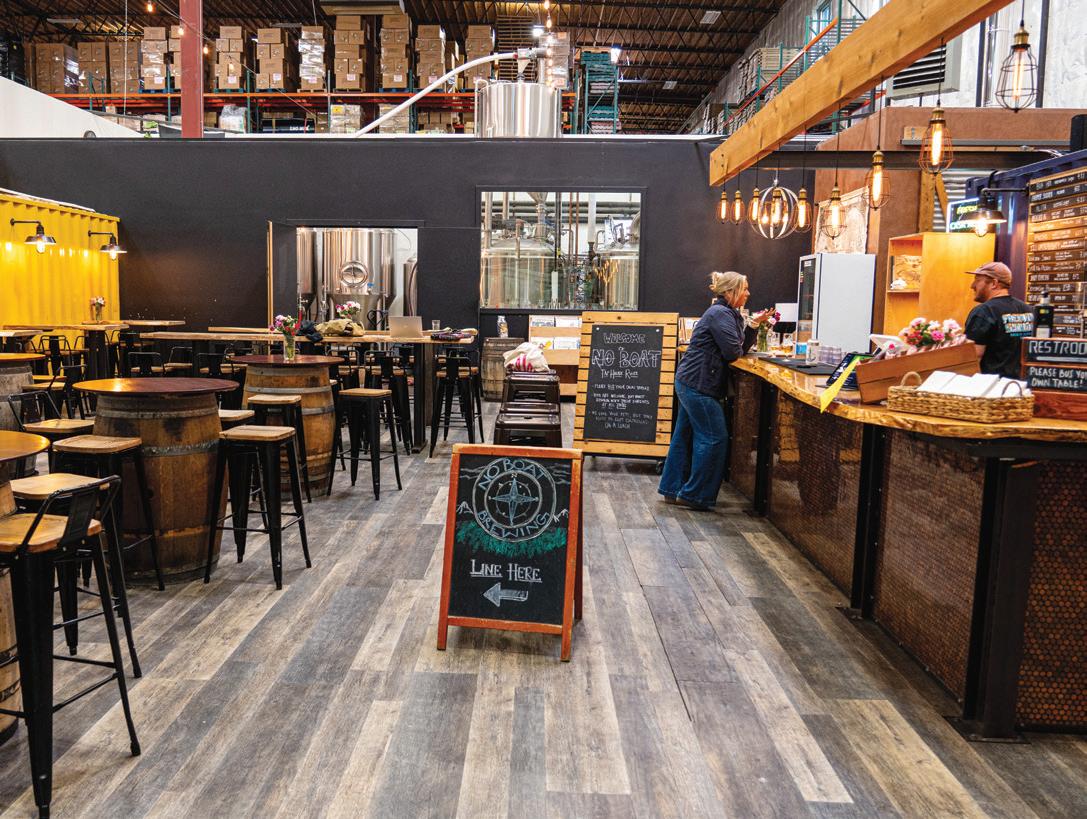

something aged in oak. While No Boat doesn’t stake its identity on any one flagship beer, it has earned a reputation for crafting expressive ales and lagers with a Northwest sensibility.
With nearly ten years of brewery ownership and a background in winemaking, you might imagine Skiba to be older than he is. He started his alcohol endeavors as a mere babe and is now just into his early-mid 30s. He’s on the young side for someone planning the ten-year anniversary celebration of their own brewery.
e taproom is open seven days a week, afternoons into the evening on weekdays, and from noon until late on weekends. It’s a rare day when the beer garden isn’t populated with young families, trail runners and a healthy number of dogs curled up in shady corners. ough there’s no in-house kitchen, No Boat partners with a rotating lineup of food trucks that serve everything from tacos and smash burgers to crispy chicken sandwiches and birria. Visitors can check the brewery’s website or social media for the daily truck schedule.
Community is central to No Boat’s identity. e staff is small and tight-knit, and many have been there for years. Regulars know them by name—Brittany, Kami, Nick, Liz, Zach—and
Combine tequila, lime juice, orange juice and agave in a shaker. Shake with ice, and pour into a salted-rim glass. Top with champagne, and garnish with lime. NO BOAT BREWING COMPANY 35214 SE CENTER ST. SNOQUALMIE www.noboatbrewing.com
most are happy to chat about what’s on tap, what’s coming next, or what trail to hit after your pint. e brewery is dog-friendly, kidfriendly and attitude-free.
at sense of inclusiveness extends to events, too. No Boat doesn’t try to be everything to everyone, but its calendar often includes thoughtful additions: collaborations with other local brewers, conservation-minded initiatives and special releases tied to causes they care about.
While No Boat isn’t trying to reinvent the brewery model, it does a lot of small things well—and that adds up to something unique. e brewery sources locally whenever possible, builds strong relationships with local nonprofits and shows up consistently for its customers and its community. e result is a brewery that feels less like a business and more like a shared backyard.
For those passing through Snoqualmie on the way to the mountains, No Boat is a natural stop. But for locals, it’s more than that—it’s part of the rhythm of daily life. e kind of place where you can meet a friend after work, show up in your hiking boots or spend a lazy Sunday trying something new on tap.
And no, there’s still no boat. But as it turns out, you don’t need one.





written by Lauren Kramer

WHEN KEVIN MORSE founded Cairnspring Mills ten years ago, his vision was craft flour: stone-milled flour made from sustainable, locally grown grains. The mill would prioritize locally grown food, deliver a fair margin to the farmers supplying the grain and mill the grain in small batches that preserved its nutritional integrity. A decade in, demand for Cairnspring flour is so strong that a second mill is in the planning.
While commodity-produced flour occupies more shelf space in grocery stores and tempts with cheaper prices, it’s milled in massive batches, stripped of its nutritional content and composed of mixed grains, their provenance unknown. By contrast, the team at Cairnspring selects specific grains, all derived from farms with regenerative farming practices, for their milling and baking quality, flavor and aroma. The grains are ground in a European-style stone mill that brings more flavor to the flour. “Flour is not just a ubiquitous, white product,” Morse said. “When you treat it like a fresh product, it tastes and performs better.” Serious bakers say they can taste the difference, vouching for the superior flavor Cairnspring’s flour brings to their bread, buns and pizza bases.
“Cairnspring is a testament to the power of community,” Morse said. “Here in Skagit County, we’ve built a business based on humanity, one that’s good for the people and the planet, and is founded on a wish to maintain a viable way of life here. This is about food safety, food security, good stewardship and prosperity, and it’s deeply personal. Yes, we’re milling flour, but what we’re really doing is revitalizing our community.”
11829 WATER TANK ROAD
BURLINGTON www.cairnspring.com
Convenience store meat snacks have long been subpar and far from tempting, but Bellingham’s Carnal restaurant is determined to up the ante. Its Michelin-trained chefs just launched Carnal Jerky, beef sticks infused with black truffles, fermented black garlic and proprietary spices. The portable gourmet snacks are sugar free and made with premium beef. www.carnaljerky.com
Cookies are seldom a lower-calorie choice, but Light Delight in Selah has a formula for great cookie snacks without the guilt. This small business avoids refined sugar and has many selections in gluten-free and dairy-free versions. Top sellers are caramel chocolate, chocolate chip and snickerdoodle, and if you prefer to bake at home, they offer mixes for select confections including cookies, brownies, carrot cake and cinnamon rolls.
117 E. 3RD AVE. SELAH www.lightdelight.net
Landsea Gomasio is the Pacific Northwest version of “everything but the bagel” seasoning, and it’s addictive, particularly when sprinkled on top of salads, rice, eggs and other proteins. The salty, nutty flavor of this Orcas Island-made blend consists of nutrientrich seaweed, nettles and sesame seeds. The company also offers Landsea Za’atar and Landsea Popcorn, and its seasonings are available at select grocery stores in the San Juan Islands and beyond (see its website for a full list).
www.landseagomasio.com
Lum Farm on Orcas Island, populated by a herd of Nubian goats and Friesian sheep, has nailed the formula for rich, creamy chèvre. The farm sells herbed and plain chèvre, feta cheese made from goat and sheep’s milk, sheep’s milk yogurt, goat’s milk ice cream and cajeta, a goat’s milk caramel. Shop straight from the farm store online, or visit them in person.
1071 CROW VALLEY ROAD EASTSOUND www.lumfarmorcas.com
Known for its butter-crusted fruit pies, wholegrain breads and incredible pastries, Anjou Bakery is an unexpected gem in Cashmere’s culinary scene. Look out for the almondine, a seductive almond cream confection, and the black bottom cupcake, a decadent chocolate cake filled with cream cheese. Arrive early, as baked goods sell out fast.
3898 OLD MONITOR ROAD CASHMERE www.anjoubakery.com
Nothing beats a light, refreshing sorbet on a warm day! Head to Clever Cow Creamery in Eastsound for a divine assortment of seasonal sorbet and ice cream from Lopez Island Creamery. Flavors like lemon drop and cucumber lime deliver a one-way ticket to blissville.
109 N. BEACH ROAD EASTSOUND www.clevercowcreamery.com
When hunger strikes in Vancouver, choose a nutrient-dense bowl packed with healthy ingredients. Mighty Bowl offers dishes with flavorful items like chipotle soy curls and cashew pesto, and also serves smoothies and toast, with a food cart, a food truck and a retail location.
108 W. 8TH ST. VANCOUVER www.themightybowl.com
On Orcas Island, don’t miss a brunch stop at the fabulous Cafe Aurora, which opened in summer 2024. Diners feast indoors or outside on the sunny patio, and the menu is filled with healthy, diverse options like oyster mushroom lettuce wraps, bananas foster waffles, homemade granola and avocado toast with harissa tahini.
123 N. BEACH ROAD EASTSOUND www.cafe-aurora.com

written by Lauren Kramer
LOCATED IN the century-old Metropolitan Building in downtown Wenatchee, Atlas Fare is one of the city’s hot spots, a restaurant with a modern, cosmopolitan feel and a diverse, globally flavored menu. Owners Top and Jenny Rojanasthien spent eighteen months renovating before opening in 2020, adding a white-tiled open kitchen, a wall with clocks depicting different time zones around the world, a sophisticated charcoal-and-white color scheme and 15-foot ceilings. The result is a popular restaurant that feels spacious, contemporary and sophisticated, seating up to seventy-eight between its dining room and bar.
Atlas Fare’s global infusion theme permeates the whole menu, from the southern-style shrimp and grits to the Italian-style paella and chicken risotto and the quintessentially Northwest crab chowder and salmon. There are options for vegetarians, vegans and those avoiding gluten on the menu.
We dined on a hot summer’s night, preferring lighter fare: a caesar salad featuring grilled romaine lettuce and a falafel entrée that arrived with pink flowers and was almost too pretty to eat. The chickpea fritters, served with quinoa and a cashew tzatziki, were a perfect antidote to the heat, while our furikake-crusted halibut, served on a bed of pea purée, was flaky and delicious, its Japanese-influenced wasabi peas and sesame seaweed topping adding a pleasantly spicy crunch to the dish.
“We love running the restaurant as a husbandwife team,” Jenny said. “We both have a pas sion for hospitality, and it’s really rewarding walking into the dining room and, instead of seeing cellphones out, seeing people genuinely enjoying our food and engaged in conversation.”
Atlas Fare is open for dinner Wednesday through Sunday, and reservations are recommended.
137 N. WENATCHEE AVE., #103 WENATCHEE www.atlasfare.com
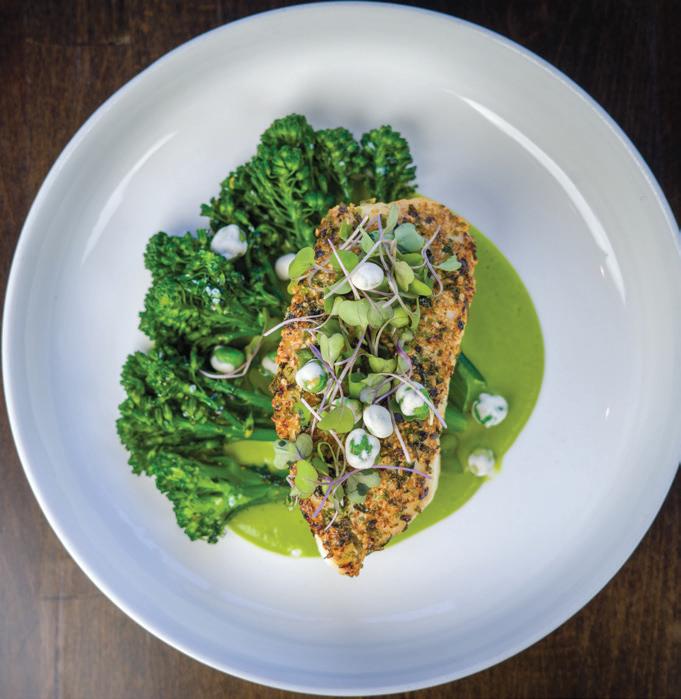


The bright legume brings flavor and crunch to dishes from Tacoma to Whidbey Island written by Corinne Whiting | photography by Will Austin

KIRSTEN MURRAY and Tommy Contreras, owners and operators of Rowdy Sprout Farm, call peas “a gateway vegetable” since “they are so sweet and crunchy, even the most veg-resistant child reaches for more a er being encouraged to take a no-thank-you bite.” They love to eat peas fresh in the field, sweet and warmed by the sun. “The first meal we ever shared included a chilled wheat berry, carrot, radish, turnip, pea and feta salad,” Murray said. “We come back to that memorable recipe time and again.”




On their diversified collaborative farm, operating out of a 1-acre incubator plot at certified organic blueberry farm Mutiny Bay Blues on the south end of Whidbey Island, peas are one of the first crops to go in the ground as the fog of winter lifts. “The plants thrive in cool weather and yield from late spring through early summer,” Murray explained. “Washington’s generally temperate weather grants us a longer window in which to produce and enjoy them!”
The couple’s collaborative farm came to be out of a shared belief that diversity lends to sustainability. Both have backgrounds working with food in spaces such as school and community gardens and food banks. While one of them grows flowers, fiber and botanical dyes, the other grows mixed vegetables—like peas.
Sean Prater, culinary director at Captain Whidbey since October 2021, loves the versatility of peas. “They read spring, but in Washington they are more of a summer treat,” he said. “The plant is great because once you harvest all the pods, you can turn around and use the tendrils as sautéed greens. They are
hardy, and their flavor is very reminiscent of the little green gems that everyone waits for.”
On enchanting Whidbey Island, where they source from at Captain Whidbey depends on the peas, but they try to go the local route whenever possible. They bring in pea shoots from One Willow Farm, and collect pea blossoms from their own garden crop.
“Our vision for our culinary program is ever changing, but the focus is local,” Prater said. “Seasonality plays a huge part in the production, but the main event is the local fare. 17,000 acres of farmland on island produce the tastiest berries, most vibrant beets, creamiest cheeses and a secret stash of wild mushrooms that is the envy of foragers the world over.” At the charming island eatery, which Prater calls “an absolute gem,” they pay homage to these artisans, shouting out their families and farms on the menu. Though their local co-op does a lot of the leg work, they want to honor their craft and products the best way they can.
Back on the mainland, executive chef Dexter Mina of Tacoma’s Woven Seafood & Chophouse agreed that the versatility of peas “naturally adds a pop of freshness and brightens up any dish.” At his

scenic new outpost on the Ruston Way waterfront, Mina specifically chose to partner with Charlie’s Produce. Woven Seafood & Chophouse’s venue blends the rich culinary traditions of the Puyallup Tribe, Hawaii and the Philippines.
Prater also recognizes the versatility of peas to be used yearround. Think: split peas in the cold months, or young peas to make soups and sauces in the spring to pair with lamb. “Summer pea salads laden with stone fruit is the perfect accompaniment to a BBQ or eclectic winemaker dinner,” he added. “Pearls hidden within their shells.”
Prater advises not selecting peas that are parched (the pods will be wrinkly). Bulging pods are always a good sign. “When cooking the peas, it’s a good idea to blanch them first, and look out for any peas that float, as this is a sign of imperfect peas,” he said. He likes to add salt, as well as a dusting of baking powder
into his blanching water. “The soda raises the pH of the peas and makes it so they stay vibrant,” he explained. “Shocking them in ice water will help hold that vibrant color.”
Another tip: Don’t throw away the pods after shelling, since dozens of uses exist. Prater suggests blending them with a little water and wasabi or green chilies to make a fiery consommé to be paired with ceviche. Or blend them with sugar and freeze, and you can make a fluffy granita by scraping the frozen mixture with a fork—a perfect accompaniment to oysters on the half shell.
Murray offered wise words to those growing peas at home. “Animals love them as much as we do,” she said. “Protect your peas! Particularly just after seeding, you will get a lot of pest pressure from birds and rodents.” If you seed directly in your garden, she advised, be sure to apply a barrier to deter pest access to the ripening seeds. Examples of smart coverage: a chicken wire cover during the day or frost cloth at night. And if you seed in a greenhouse, also be sure to protect the seeds.



Pork Guisantes (Filipino-Style Pork ’n’ Peas)
Woven Seafood & Chophouse / TACOMA
Dexter Mina
SERVES 4-5
• 2 pounds pork belly, cut into ½-inch strips
• 2 pounds pork shoulder, cut into medium-size strips
• 1 yellow onion, small dice
• 4 tablespoons garlic, minced
• 2 tablespoons fish sauce*
• 2 tablespoons soy sauce (or tamari for a glutenfree option)
• 2 tablespoons tomato paste
• 4 tablespoons peppercorn, freshly cracked
• 4 bay leaves
• 1 to 2 cinnamon sticks (or 1 to 2 teaspoons ground cinnamon)*
• 2 red bell peppers, julienned
of the pork fat. Using the reserved fat, sauté the onion and garlic until fragrant. Next, add your pork belly and shoulder back into the pot, and stir to combine.
Deglaze the pot with fish sauce and soy sauce, and scrape the bottom of the pot to get all those flavorful bits. Add the tomato paste, cracked black peppercorn and bay leaf to the pot. Pour in enough water to cover, and bring to a boil.
While waiting for it to boil, in a separate pan or in the oven, toast the cinnamon sticks until they start to unravel and release their aroma. Add to the pot. (If using cinnamon powder, add when adding the black peppercorn and bay leaves.)
(Typically, peas are out of the danger zone after they reach a height of 2 to 3 inches.)
Prater leans heavily on Asian cuisine at home, so he’s fond of quick sautés using snap and snow peas. His crowd-pleasing appetizer involves tossing snap peas and shishito peppers with oil and salt, and then broiling them for several minutes until they bubble and blister. For the finale, a heavy dash of fish sauce mixed with sweet chili glaze.
“Green peas are best when they’re super fresh, so be sure to look for pods that are bright green and feel nice and full. If they look a little dull or feel soft, they’re probably past their prime,” Mina said. If planning to use peas within a couple of days, he said, after shelling they can be stored in an airtight container and kept in the fridge.
When green peas are in season, at home, Mina likes to add them as a last-minute garnish; this adds yet another layer of texture and brightness—something peas subtly, yet successfully, seem to do best.
• 2 cups fresh green peas (or frozen if not available)
• Salt, to taste
Start by cutting and preparing all pork and vegetables. If using fresh peas, shuck them, and set aside.
Add the pork belly to a large sauce pot, and render out the fat until the pork has been browned. Reserve some of the fat for later sautéing. Remove the pork belly, and add the pork shoulder. Render and sauté until browned, and then remove, leaving in some
Braise until the meat is tender. Once the meat is tender, add in the red bell peppers and green peas.
Season with salt, pepper and, if desired, additional fish sauce, to taste. (I recommend fish sauce.)
*Notes from chef Dexter Mina: I prefer cinnamon sticks over powder, as the powder is a little stronger in flavor than the sticks. You don’t want the dish to be too “cinnamon-y.”
For fish sauce, I prefer using the Vietnamese 3 Crabs brand as it’s a little stronger and pungent to even out the sweetness of the dish.

farm to table

Spice Waala / SEATTLE
Aakanksha Sinha and U am Mukherjee
SERVES 3-4
• 3 tablespoons vegetable oil or any other high-heat cooking oil
• 2 teaspoons cumin seeds
• 1 onion, diced
• 3 tomatoes
• 2 Thai green chilies, diced
• 1 tablespoon ginger paste
• 1 tablespoon garlic paste
• 1 tablespoon methi, crushed
• ½ teaspoon Kashmiri mirch
• 1 tablespoon coriander powder
• 1 tablespoon cumin powder
• 1 tablespoon garam masala
• 1 cup peas, at room temperature
• 1 12-ounce packet of paneer, at room temperature and cut into ½-inch cubes
• 2 strands coriander leaves, finely chopped
• Salt, to taste
On the stovetop, in a 12-inch-deep sauté pan, heat oil to 300 degrees over medium heat. Add cumin seeds to lightly fry for about 30 seconds (make sure it doesn’t turn deep brown).
Smoked Scallop Carpaccio with Glazed English Peas, Rhubarb Sriracha and Braised Daikon
Captain Whidbey / WHIDBEY ISLAND
Sean Prater
SERVES 4
FOR THE SMOKED SCALLOPS
• 12 diver scallops
• 2 teaspoons kosher salt
• 1 quart water
FOR THE BRAISED DAIKON
• 1 daikon radish, peeled and sliced into 1-inch rounds

Lower the flame to low-tomedium, and add the diced onions to the pan. Sauté until goldenbrown, about 10 minutes. Add the tomatoes, Thai chilies, ginger and garlic paste, and cook for about 10 minutes. (Add a few spoons of water if the pan is too dry).
Add all the spices (methi, Kashmiri mirch, coriander powder, cumin powder and garam masala).
If the spices make the ingredients in the pan too dry, add quarter cup of water, and let it all cook for about 10 minutes. Once the spices are cooked, add about 2 cups of water, and cook for about 10 minutes.
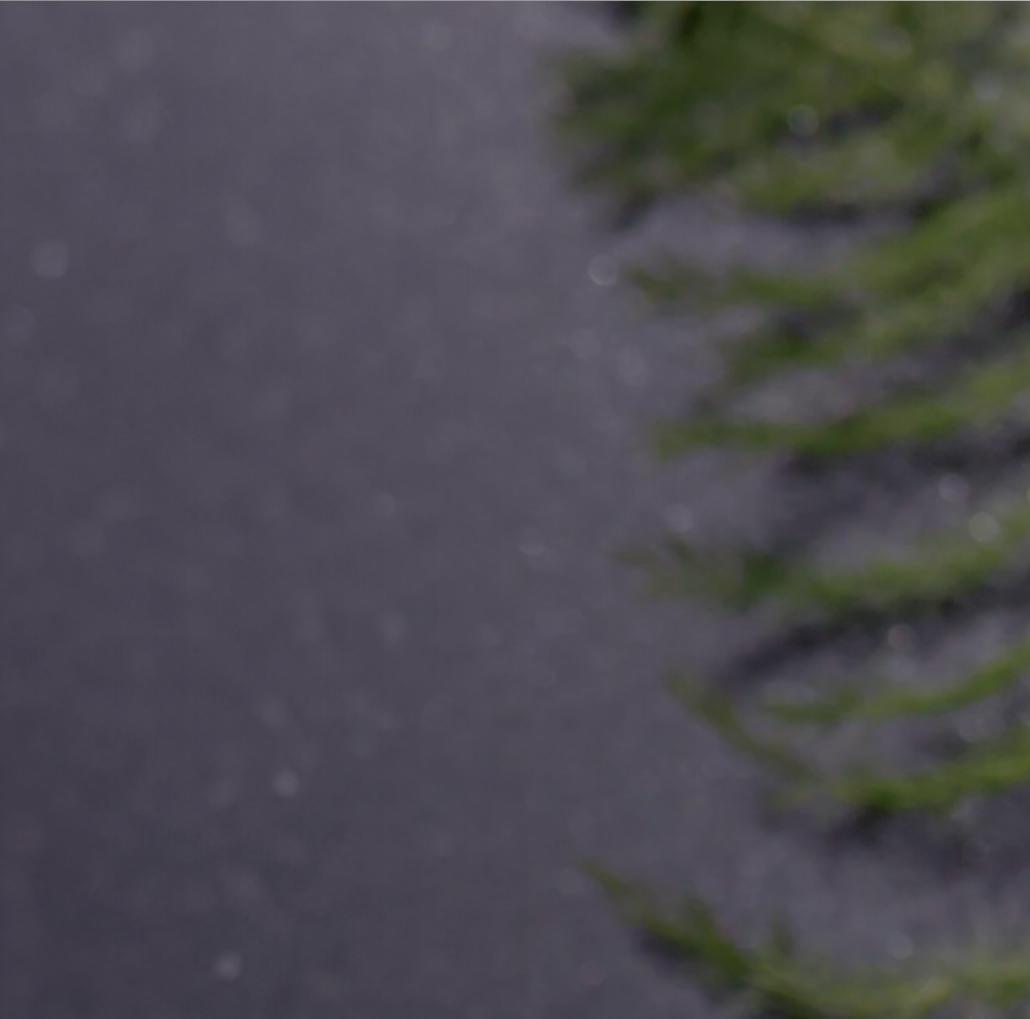
• 1 cup balsamic vinegar
• 1⅓ cup tamari soy sauce
• 1 cup brown sugar
FOR THE RHUBARB SRIRACHA
• 1 cup rhubarb, chopped
• 1 cup red wine vinegar
• 1 teaspoon cayenne
• 2 garlic cloves, chopped
• 1 cup sugar
FOR THE PEA PURÉE
• 3 cups English peas (later divided into 2 cups and 1 cup)
• 1 teaspoon sugar
• 2 teaspoons kosher salt
TO SERVE
• Olive oil
• Salt

Add the peas and paneer, and mix everything to coat the paneer and peas evenly. Cook on low flame for about 5 minutes, and switch o the stove. Add salt to taste. Garnish with fresh cilantro, and serve with hot basmati rice.
FOR THE BRAISED DAIKON
Peel the daikon, and ensure it is uniform in diameter. Cut into 1-inch rounds, and add to a medium pot with the balsamic, tamari and brown sugar.
Simmer on low for 45 minutes. Remove from heat, and allow the daikon to marinate in this mix overnight. Reserve a teaspoon of the braising liquid for serving.

• Pea shoots
• Edible flowers
FOR THE SMOKED SCALLOPS
Begin by cleaning the scallops and removing the li le side muscle that is a ached to each scallop. Make a brine by dissolving the salt in the water. Brine the scallops overnight or for 8 hours.
Drain the scallops, and pat dry. Allow the scallops to fully dry and become tacky—this will allow the smoke to adhere.
Smoke the scallops using a light wood (apple or peach) at 160 degrees or less for about 12 to 15 minutes.
Cool the scallops, and allow the smoke to mellow out and disperse.
FOR THE RHUBARB SRIRACHA
Chop up the rhubarb, and add to a medium pot with the vinegar, cayenne, chopped garlic cloves and sugar.
Simmer for 10 minutes or until the garlic is tender. Add this mixture to the blender, and blend on high until very smooth. Set aside, and allow to cool.
FOR THE PEA PURÉE

Blanch all the peas in salted water for 1 minute, and shock in ice water. Divide the peas into 2 cups and 1 cup.

Add the 2 cups of peas to the blender with ¾ cup of water, the sugar and salt. Blend on high until very smooth and not gri y or grainy. Set aside, and chill.
TO SERVE
To build the dish, slice each scallop into 5 or so slices, as thin as you can. Do the same for the daikon. Dress the remaining 1 cup of blanched peas in good olive oil, salt and a teaspoon of the braising liquid from the daikon.
Spread a thin layer of the pea purée across a plate, and top with the scallops and daikon slices, alternating each. Top with the dressed peas, and add some dollops of the sriracha on the plate, but to the side of the dish.
Top the dish with pea shoots and edible flowers, preferably pea or chive blossoms.





Restaurateur Quynh-Vy Pham finds vast open spaces in the modest square footage of a renovated house.


A Seattle restaurateur remodels her house to make space for family and friends written by Melissa Dalton | photography by Rafael Soldi
WHILE HER businesses and social life were on hold during COVID-19 lockdowns, Quynh-Vy Pham knew exactly what she wanted in a post-pandemic future. “A party house,” said Pham with a smile. No surprise there, as Pham comes from a family well-known for their hospitality.
In 1982, Pham’s parents opened Phở Bắc, the city’s first phở shop, in Seattle’s Little Saigon neighborhood. The restaurant soon became a popular local spot and added more locations, and forty years later, the Pham family was dubbed “the first family of phở” by The Seattle Times. Sometime in the aughts, that first restaurant acquired an assemblage of a leftover parade float shaped like a ship’s bow, to become colloquially known as “The Boat.”
The second generation, including Pham, one of her three sisters and their brother Khoa, since expanded their offerings to include a coffee shop, the Phở Bắc Súp Shop and a chicken and rice shop (the latter now in The Boat since 2022). There’s also a hidden bar called Phởcific Standard Time inside one of the Phở Bắc locations, where you can order a “Quynh Bee,” Pham’s take on the classic Queen Bee cocktail, made with jasmine-infused honey. “That’s my signature drink,” said Pham. “I make it for anyone who comes over.”
But in 2021, Pham had inherited her brother Khoa’s house, after his unexpected passing. He had been fixing it up off and on, adding skylights here, painting the siding charcoal and the window frame a bright fuchsia. Later that summer, Pham decided to continue what he had started. “Being in the restaurant biz, [the pandemic] was really tough, so I had a lot of free time on my hands,” said Pham. “I thought, might as well go ahead and start this project.”
The house is a familiar fixture in the Leschi neighborhood, and its existing, boxy facade belies a colorful past. Built in 1927, it was first an art studio for Louise Crow, a renowned portrait painter born in Seattle. In the 1940s, the home’s shingled exterior was painted white to become a Baptist church. By 2016, when Khoa bought it, it was about 1,000 square feet, on a petite 2,835-square-foot lot tucked tightly between two other houses. Pham wanted to update it in a way that paid homage to her personal history, as well as the neighborhood, so she reached out to SHED Architecture & Design for the job, noting that their office is kitty-corner to The Boat. “I just remember Khoa talking about it,” said Pham. “He said, ‘I’ll just reach out to SHED. They’ve been our neighbors for twenty years.’”
For the remodel, architect Rebecca Marsh and firm principal Prentis Hale used the fact that the house came with several non-conforming land-use
home + design
conditions to their advantage. Those conditions drove them to design a clipped flat roof at the second story, creating a soaring ceiling in the dining room, and two bedrooms and a bathroom. As might be expected given Pham’s family business and love of entertaining, the kitchen was enlarged and moved to the rear of the home, to connect to a new backyard patio via large sliding glass doors. “Quynh really wanted a home that would work well for entertaining,” said Marsh.
“She wanted a house that was expandable—that felt natural for her and one other person if they’re cooking, as well as a party of thirty people.”
Custom storage in unique configurations enhances the sense of expansiveness. A 40-foot-long bench by Space Theory lines the living and dining room walls, to act as media console, art display and seating at the table. High cabinets, also by Space Theory, accessed by a library ladder underscore the dining room’s tall ceiling, while a 12-foot-long kitchen island is perfect for accommodating family cooks at work and mingling guests. “This is a modest house in terms of square footage, but it is dynamic,” said Marsh.
Certain preserved pieces nod to the building’s past, such as the brass pendant light from the church


The soaring ceiling height in the dining room opens up to friends and family. Sizeable windows in the living room help create a naturally lit space that feels larger.




that hangs over the staircase. When the team installed a larger window on the front facade, the old one from Crow’s studio was worked into the redesign. “We were debating what to do with it—will it be an art piece, where will it go?” remembered Marsh. During a design meeting over drinks, Pham passed on a few concepts for the staircase, and the team “jokingly” suggested using the old fuchsia-painted window as the stair guard rail and an interior screen. Pham was all in, and upon review of the measurements the next day, it was a perfect fit. It’s now painted a paler pink, with reeded privacy glass, and incorporates seamless closet space at the entry.
Also preserved throughout? The family’s love for the color pink, now woven into the home from the front window to the kitchen cabinets. “When my parents first opened the restaurant in 1982, my dad painted the restaurant pink,” said Pham. “He just loved pink. Throughout the forty-something years, the restaurant has always been some version of pink, and pink has always been the theme through the business and translating into our lives.” Perhaps because, much like a good gathering of family and friends, food and drink, it’s a color that, said Pham, “just brightens everything up.”
“When my parents first opened the restaurant in 1982, my dad painted the restaurant pink. He just loved pink. Throughout the forty-something years, the restaurant has always been some version of pink, and pink has always been the theme through the business and translating into our lives.”
— Quynh-Vy Pham, homeowner
ABOVE The kitchen features a 12-foot-long island that also provides ample storage. AT FAR RIGHT, CLOCKWISE FROM TOP LEFT A brass pendant light illuminates a nook. An old window was repurposed for an interior stairway. The back patio is a peaceful respite.




illustration by Jenna Lechner
IF YOU’RE looking for a creative way to save some space in your kitchen (who isn’t?), this easy-to-make pot rack and shelf may just do the trick.
Cut a 1x12 board to 36 inches long. (The real dimensions of a 1x12 will be 3/4 inch x 111/4 inches wide.) Using 150-grit sandpaper, sand every plane of the board, making sure to buff the edges so they are not sharp. Stain or paint, and seal the shelf to the desired finish. Make sure all the steel plumber’s pipe and pieces have the same diameter, such as a ½ inch, so they will connect properly. Clean the metal pieces with all-purpose cleaner. Spray paint every piece for a consistent finish and to keep the pipe from rusting in the kitchen humidity.
Measure 2 inches from the sides of the shelf, and attach an L bracket
on either end. These brackets should be placed at 32 inches apart so that they will connect with the wall studs, which are typically spaced 16 inches apart on-center.
The shelf requires an additional wall support on either side. The supports are connected across the front with a 32-inch pipe. (This long pipe is where the kitchen utensils will hang from with hooks). Each support is constructed from two flanges, two pre-cut pipes in two lengths (6” and 8”) and a three-way elbow connector. Screw the 8-inch pipe into the wall flange. Attach the elbow at the other end. Screw in the 6-inch pipe so it runs vertically to meet the
underside of the shelf. Attach the flange to the end of the 6-inch pipe. This flange will be screwed into the underside of the shelf. Repeat for the other support.
Flip the shelf over, and lay it on the ground with the underside facing up. Put the back edge up against the wall so the L brackets are flush with the wall. Line up the flange that will be connecting to the shelf, so that it is in line with the L bracket. Slide the flange along the bottom of the shelf until the bottom flange is flush with the wall. This should put the upper flange at 2 inches from the side and front edge of the shelf, but the most important thing is that the support lines up with the L brackets. Mark the flange location on the board. Using a 3/4-inch screw, attach the flange to the board without tightening all the way. You want it to have some give when attaching the crosspiece. Repeat on the opposite side with the second side support.
Add the 32-inch crosspiece between the side supports, threading it into the remaining hole on the three-way elbow. Once the crosspiece is in place, tighten the flanges at the shelf so they are secure.
Use a stud finder to find the wall studs, and mark their location. Screw in one side, including both the L bracket and wall flange. Use a level to make sure the shelf is straight. Screw in the opposite side. Add S hooks, bending them so they fit tight around the pipe, otherwise they may fall off every time a pot is removed. Hang up kitchen utensils, the family cast iron or some herbs to dry, and marvel at your new functional, space-saving display.









Scott Hudson started Henrybuilt in Seattle in 2001, marrying American craft tradition with the look of sleek European kitchen systems, to become the first “American kitchen system.” In 2019, they opened Space eory, a new kitchen system line of cabinetry and more that’s simplified and affordable, but still high quality. Built in Seattle, the company’s offerings are known for their hyper-organizational capabilities and offer more than forty finish selections. www.spacetheory.com



e fun thing about the modular Alphabeta lighting system from Hem is that the shades come in eight shapes and a wide range of colors and can be customized to your preference. ( e company says there are 1,024 different configurations possible.) Which will be yours—monochrome, or a color combination only you can imagine?
www.hem.com/en-us


A utensil holder is an undersung, hardworking piece in the kitchen. Sure, you could use any old mason jar for the job—or, upgrade to the French Kitchen Marble Utensil Holder from Crate & Barrel. It will hold more tools, and look good doing it.

www.crateandbarrel.com



is 3-quart, enameled cast iron by Staub at Williams Sonoma is perfect for simmering sauces and soups or baking no-knead bread, as it’s oven safe up to 500 degrees. Plus, the enamel is available in fun colors for a bright spot on the stove. Why not pink?

www.williams-sonoma.com
BLAINE FIGURE SKATER Liam Kapeikis was surrounded by figure skaters growing up. His parents had met performing in Disney on Ice, and his two older sisters loved the sport, too. But until he turned 7, there were no boys figure skating in his hometown of Wenatchee. It wasn’t until 2011, when another boy joined the sport, that Kapeikis laced up his skates and began figure skating in earnest.
With his parents coaching him, success came quickly, and soon Kapeikis was winning competitions. The typical time frame for going from single to double axel is five years, but Kapeikis had his single at age 11 and, twelve months later, had nailed the double axel. “As I grew older, I fell in love with figure skating and just knew it was what I wanted to do,” he said. “I realized I could go places and travel the world with my skating. Who wouldn’t want to do that?”
At 15, Kapeikis moved to Surrey, B.C., to be closer to the Connaught Skating Club at the Richmond Olympic Oval, where he could train in a more serious environment. “Back home there were only two of us who could do triples,” he explained. “In Richmond, there are fifteen of us just in my group who do triples, and being surrounded by that is so inspiring.”
but no off-ice training, and competitions were by video. Kapeikis’ motivation plummeted, and he placed ninth in the U.S. Nationals that year. “It was terrible,” he recalled. “But I figured I could either give up, or work twice as hard. I chose the second option.”
Born: Wenatchee
Lives: Blaine
Age: 21
“I train five hours a day, six days a week. I work on the ice close to four hours a day and spend the remaining hour alternating between pilates, ballet and weight training.”
“I follow a healthy diet that’s heavy in carbohydrates, because I need the energy, and in red meat, because I’m anemic and need to supplement my iron. I try to avoid junk food.”
“My older sisters, figure skaters, too, really inspired me to work hard at figure skating when I was a child. My sister Kaela, 28, performs in Disney on Ice, and she can really control an audience. I’d love to perform like she does.”
In 2019, he placed fifth in the U.S. novice championships, and in 2020, he placed third in the U.S. Junior Nationals. That year he relocated to Blaine, from which he commutes six days a week to the Oval to train in a facility that’s nothing short of exceptional, he said. “The skating level at the Connaught Club is very competitive, and being surrounded by that is so inspiring. The Oval contains all the resources I need under one roof, and I get to train with Wesley Chiu, the 2024 Canadian champion!”
The year 2020 was hard for athletes, and Kapeikis was no exception. Everything shut down during the COVID-19 pandemic, and he was off the ice for three months. After that limited ice time was permitted,
His hard work paid off in 2022, when Kapeikis had one of the best performances of his career. Competing against Olympians in the Nationals’ senior division, he placed seventh. In 2023, he competed in Skate Canada, the Grand Prix in the U.S. and the Four Continents Championships. In 2024, he was at the Grand Prix in Finland, too.
“I love performing, showing an audience what I can do,” he said. “My favorite time at the competitions is the thirty-minute practice sessions we get in the days leading up to the competitions. That’s where we get to skate with the best skaters in the world, and their power and speed is incredible. When I watch those exceptional skaters, it inspires me to skate even better.”
Figure skaters usually retire from the sport between the ages of 25 and 30, so Kapeikis still has time to complete his goals: to compete in a World Championship, and in the Olympics. “The 2026 Olympics is a possibility for me, but it’s unlikely. So I’ll probably stick around until the 2030 Olympics,” he said.
In the meantime, he coaches other skaters in Bellingham and is studying engineering at Simon Fraser University. “Skating will always be a part of my life, and I love it, but I’ll know when it’s time to move on,” he said.
“I’m grateful for everything it has given me—discipline, with respect to setting goals and working hard to achieve them,” he continued. “The skating world is like a family, and it’s great to have that sense of community and support. It’s been especially important in the wake of the American Airlines’ plane crash in January, which claimed fourteen members of the figure skating community. We’re coming together to help each other get through this.”


Elite ice skater Liam Kapeikis strives to reach Olympic goals written by Lauren
Kramer










The Modern Dane offers transparently produced sustainable bedding with the environment—and consumer—in mind
written by Rachel Gallaher
LIKE MANY people living in the Puget Sound region, Jacob Andsager moved to Washington for a job in the tech industry. Originally from a small town in southern Denmark, Andsager—who launched a natural bedding company called The Modern Dane in 2019—landed in the United States in 2002 to study information architecture at the Illinois Institute of Technology and then earned an MBA in marketing, finance and managerial analytics from Northwestern University’s Kellogg School of Management.
“I wanted to be the online editor of Newsweek magazine,” Andsager said, “but instead I spent a couple of decades working for a series of Fortune 500 companies, including Amazon for ten years.” He remembers a tour he took in one of the online retailer’s fulfillment centers, watching the workers packing up orders from thousands of customers.
“The operations were really impressive,” he said, “but I felt a little nauseated by the consumerism [on display] and started thinking about my own role in that cycle. Was I going to work every day to help crank out more stuff?”
After his wake-up call, Andsager tried transferring to several different roles within the company, hoping to find something that had a better social impact, but ultimately walked away to pursue a venture that felt more aligned with his core values.
“I wanted to build my own thing and do it the right way,” he said. “I wanted something that would have a positive impact on both consumers and the environment and connect back to my roots.”
After exploring several options, Andsager landed on bedding—a category where he saw significant room for improvement. Learning in his Danish heritage (the Danes are known for their design aesthetic and high-quality products that enhance daily life) and environmental concerns, he introduced The Modern Dane, a line of duvet covers, pillowcases and sheets crafted from organic European flax linen grown in France and Belgium. In addition to a rich selection of neutral colors, the linens come in nature-inspired patterns reflective of the Scandinavian outdoors.
“A lot of what I saw out there was uninteresting on the good side,” Andsager said, “and on the bad side, full of chemicals and pesticides and produced with child labor. I saw this as an opportunity to do something that tied back to my values. … I believe that good design can improve our lives.”
Each item from The Modern Dane is hand-sewn in Portugal, which is considered the hub of European textile craft. To meet rigorous environmental standards, Andsager is committed to using only materials with the following certifications: GOTS (Global Organic Textile Standard), OEKO-TEX and European Flax. This means that every step of the production process is held to strict standards, ensuring environmental and human safety. Andsager also noted that growing linen is a carbon sink, reducing the amount of carbon dioxide in the air. The cotton industry, on the other hand, pumps chemicals in the environment and produces hundreds of millions of tonnes of carbon annually.
The Modern Dane’s products are currently available directly to consumers via the company’s website, a model Andsager says helps reduce price points. It doesn’t mean that the bedding is cheap—a full/queen duvet cover starts at $328—but for those concerned about their environmental or dollar-spend impact, it’s a high-quality, durable and transparently produced choice.
Andsager understands his consumers are a niche group, and he plans to launch towels, pajamas, bathrobes and shower curtains, all the company’s trademark organic European linen, as a more attainable option. “We’re not trying make something for the sake of it being a high-cost luxury good,” Andsager said. “We’re trying to make things the right way. It’s something that you put against your skin—an investment in your nightly sleep.”
















Bunny Dickson has built her entire career on creating community through food sourcing and culinary experiences. “I’ve worked on farms, brickand-mortar restaurants, food trucks, cruise ships,” she said. “I search for companies aligned in similar values which I hold true for myself community, quality, sustainability and leaving something be er for the next generations.” Today, she focuses her energies as a plant operations manager at Hama Hama Oyster Company in Lilliwaup.

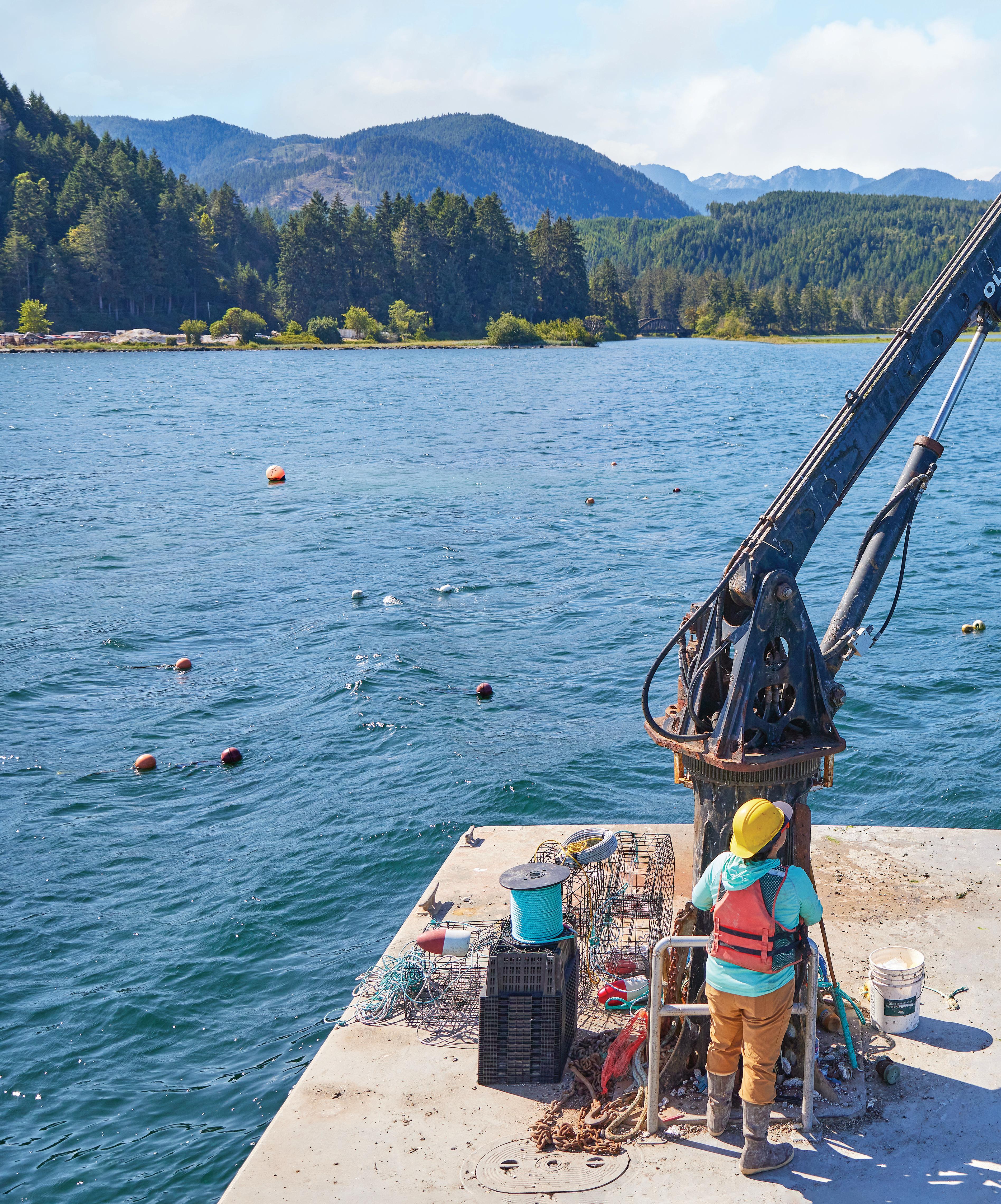














Dickson started working in the food industry as a produce clerk in 2008 while living in San Francisco. She especially enjoyed working with local farms within a 90-mile radius of her home. “I learned about the hard work ethic of our local farmers and what it takes to get food from the soil to one’s table,” she said. “From humble beginnings as a produce clerk, I wanted to dig my hands into the soil and sand to truly understand what it takes to be a part of our food cycle.”








Dickson started her job as a farm intern at Hama Hama Oyster Co. working closely with fourth-generation oyster farmers in all kinds of inclement weather, such as rain, snow and sleet, as well as on warm, sunny coastal days. Working hard is part of her innate values. “We work hard, long hours, in all conditions, with a big, fat smile on our faces,” she said. “It’s not easy work, but it sure is rewarding being able to say that I can work a night tide, operate a crane and shuck oysters!”





Strong teamwork is found at the pinnacle of Hama Hama, and Dickson appreciates the company she shares with her co-workers. “There are so many moving parts, and I am honored to work with my partners at Hama,” she said. When Dickson is not at work, you can find her riding her mountain bike, cooking on the grill with friends and family or hanging with her two cats, Stormy Bear and Mojo.







Take a free guided tour of our historic Washougal Mill. Get a behind-the-scenes peek at our process, from dyeing the wool to the finishing touches. Sign up online at pendleton-usa.com.
FIND OUR STORES A SHORT DRIVE FROM ANYWHERE IN WASHINGTON. Located in Washougal, Seattle, Tulalip, Centralia, North Bend and Spokane See more locations at: PENDLETON-USA.COM















WOVEN IN T HE NO RT HWE ST SINCE 1863






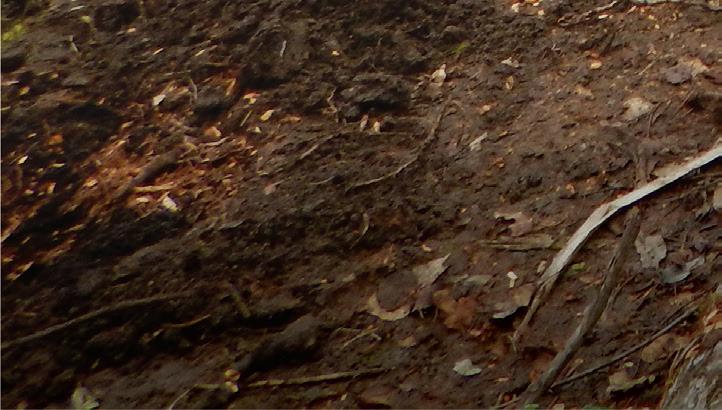


ALL ACROSS WASHINGTON, but especially in counties like Whatcom, salmon and steelhead form part of the community. For this reason, the Bellingham-based Nooksack Salmon Enhancement Association (NSEA) endeavors to connect local people with local fish and watersheds. The benefits of such collaborative and restorative work are clear as an ideal spawning stream.

Nooksack Salmon Enhancement Association brings a sense of community to restoration
written by Daniel O’Neil

Founded in 1990, NSEA, a nonprofit organization, is one of fourteen regional fishery enhancement groups in Washington. By focusing its e orts on Nooksack River tributaries in eastern Whatcom County, and le ing the Lummi and Nooksack tribes take on the large-scale work in the mainstem river, NSEA restores and monitors the critical areas where salmon and steelhead spawn and rear.





Most salmon recovery entities rely on numerous engineers and project leads to get things done, but they don’t always involve the community. Besides executing its own projects removing fish passage barriers and planting native vegetation, NSEA brings people of all ages and backgrounds to restoration sites where they not only do important work but also take away a deepened sense of place.
“ at is such a key integral part of promoting and sustaining this work,” said NSEA executive director Annitra Peck. “We all have to be taking care of our watersheds. at means we all need a working understanding of how important watersheds are and what their functions are, and then where salmon play a role in that and where we can play a role to give back in that system.”
NSEA’s salmon recovery partners appreciate this communitywide resource. For instance, when an entity has a large restoration project to undertake but lacks the community outreach to bring in necessary volunteer help, NSEA will partner in order to provide its legion of helpers. In doing so, NSEA also helps amplify the message of the important work being done.
Over the past thirty-five years, NSEA has hosted more than 1,300 volunteer work parties. From planting native trees and




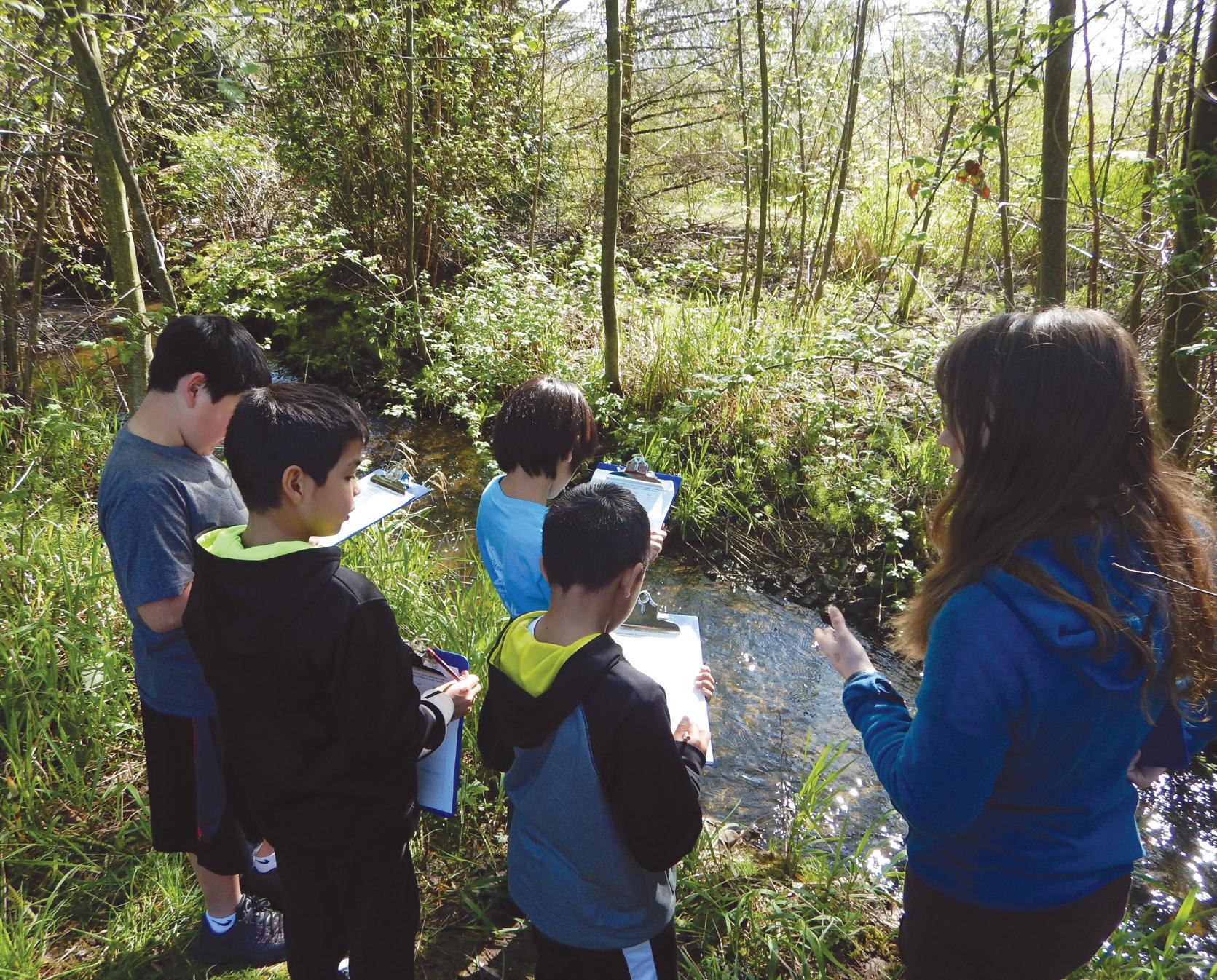
plants in salmon habitat, to counting fish, NSEA teaches people how to help. Education events further develop understanding and spread the word. NSEA also heads to fourth-grade classrooms across Whatcom County and at the Lummi Nation School. is school program engages kids in the workings of fish, habitat and restoration, both in the classroom and in the field.
“We’re always finding new ways to do things and new ways to engage people, furthering the work and promoting more energy towards this sector,” Peck said. “We definitely need more young people interested in science and attending to climate change issues, and carrying on all the good work that’s been done.”

For John ompson, senior salmon recovery planner for Whatcom County, NSEA’s participation on all levels of salmon and steelhead restoration is indispensable. “NSEA brings a unique mix of community connections to landowners and agencies, a dedicated staff that takes action daily restoring habitat, and a supportive and innovative board of directors,” he said. “ ey are a leader among the regional fisheries enhancement groups that work across the state.”
e bulk of NSEA’s funding comes from government grants, a newly endangered species. With no funding available for projects in 2025, NSEA instead turned to community members for donations and volunteer hours to revisit 157 restoration
“legacy” sites that they hadn’t seen in more than twenty years. Relationships with landowners have been renewed, sites have been evaluated and even improved, and the connection between community and salmon country has expanded.
“We were operating out of a closet at one time, and now we have our own campus,” Peck said. “ is is different than any we’ve experienced, but we do have the resiliency that we’ve built through other challenges to help us navigate through this.”
NSEA doesn’t just help and teach about some of nature’s most perseverant species, salmon and steelhead. It has learned from those fish, too.


The artful allure of the San Juan Islands

written by Ryn Pfeuffer






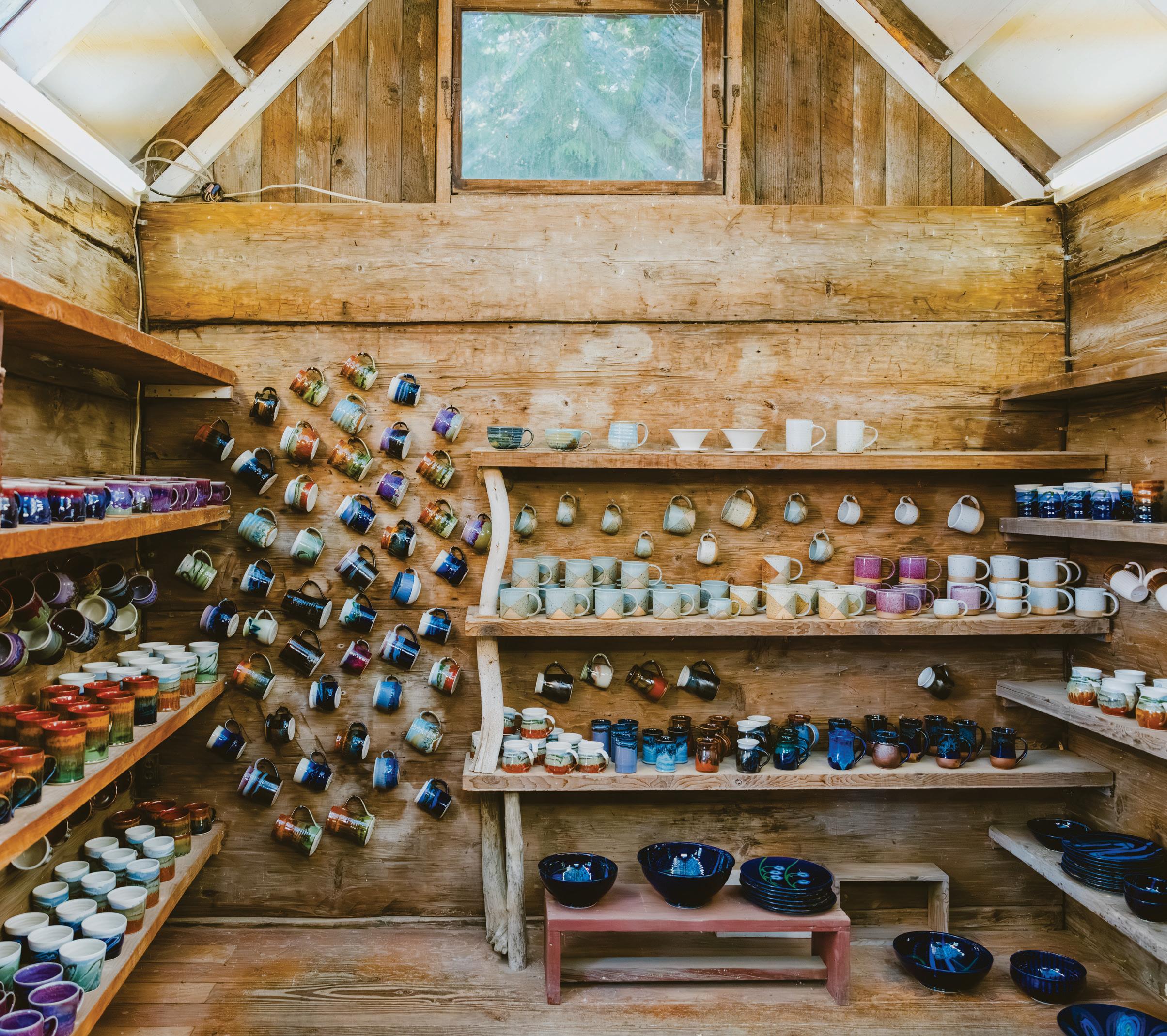
The San Juan Islands have always had a creative pull—long before art studios dotted Friday Harbor or Lopez Village. Coast Salish peoples shaped this legacy through carving, weaving and storytelling rooted in place. Today, their in uence endures in striking public art, from Musqueam artist Susan Point’s Interaction house posts to contemporary works by Lummi Nation artists like Jewell James and Dan Friday.
Throughout the islands, creativity feels rooted and personal, whether it’s a painter interpreting the shi ing light on a dri wood-strewn beach or a glassblower capturing the movement of orcas in molten color. You’ll nd artist co-ops in historic buildings, galleries tucked into back gardens and studios that welcome curious visitors. And with annual events like the San Juan Island Studio Tour and the Friday Harbor Film Festival, there’s always a new story being told.
This is a place where art isn’t just decoration—it’s a means by which people connect to the natural world, to one another and the past. The San Juans don’t just attract artists—they shape them.



Whether you’re coming for the orcas or the oysters, San Juan Island has a nature-woven arts scene that’s as much a part of the landscape as the madrona trees and the sparkling Salish Sea. Step off the ferry into Friday Harbor, and you’re instantly immersed. is laid-back port town is the island’s cultural hub, where galleries, studios and public art are all easily explored on foot.

Begin at WaterWorks Gallery, a local institution since 1985 that leans into contemporary fine art and studio jewelry, often inspired by the Pacific Northwest’s light, water and line. Just around the corner, Arctic Raven Gallery provides a respectful and powerful showcase of Northwest Coast Indigenous art, featuring carved masks, silver bracelets etched with salmon and orca motifs and prints and sculptures by Coast Salish, Haida, Lummi and Tlingit artists. Here, you’re not just seeing art—you’re stepping into deep, place-rooted storytelling.
Plan your visit for a Saturday, if you can, when the Farmers Market brings out painters, potters and fiber artists alongside fresh-baked pies and live music. e town’s summer gallery walks also add a festive spin to the scene—follow the laughter and the lavender lemonade. Local gems, such as Luminous Gallery and Friday Harbor Atelier, welcome drop-ins and often host artist talks and demonstrations. Keep an eye out for public installations, too, like the monumental cedar house posts at Fairweather Park. Carved by Musqueam artist Susan Point, Interaction depicts the interconnection of humans and animals, standing as the island’s first formal acknowledgment of its tribal heritage.
To go deeper into the creative process, head just outside town to




Alchemy Art Center, where community ceramics, printmaking and artist residencies collide in the best way. eir seasonal “Art in the Park” popups bring tile murals and hands-on workshops to outdoor spaces, while June’s San Juan Island Artists’ Studio
“Whether
you’re coming for the orcas or the oysters, San Juan Island has a nature-woven arts scene that’s as much a part of the landscape as the madrona trees and the sparkling Salish Sea.”













Tour lets you step directly into more than twenty working studios. From sculptors and ceramicists to weavers and woodworkers, this is your chance to chat, watch and maybe even come home with something one-of-a-kind (and still warm from the kiln).
Once you’ve explored Friday Harbor’s artistic core, hop in the car and head north toward Roche Harbor for a change of pace. Here, the San Juan Islands Sculpture Park sprawls across 20 pastoral acres, where more than 150 sculptures peek out from meadows, woods and waterfront trails. You’re encouraged to wander, touch and even picnic among kinetic works, bronze wildlife and whimsical abstractions. Come spring, the iconic Daffodil Frolic event dazzles with more than 9,000 blooms in April and May, and summer brings the Summer Art Series—Sunday workshops where families can create site-specific pieces that blend into the parkscape.

Along the way, consider calling ahead to visit some of the island’s working artists. Ceramicist Paula West creates earthy, soda-fired pottery from a tucked-away studio. You’ll also find Doug Bison’s bronze sculpture K-5, honoring the killer whale “Sealth,” standing watch at the Ralph Munro Whale Watch Park, a tribute that blends his Lakota heritage with local marine lore.
And don’t count the island out in fall. October brings Artstock, a weekend art celebration with gallery openings and artist receptions. Later that month, the Friday Harbor Film Festival draws cinephiles and creatives from all over with a lineup of documentary films focused on conservation, exploration and stories that matter. Panels, pop-up art shows and filmmaker meet-and-greets round out the experience, making it clear: On San Juan Island, creativity doesn’t take a season off.




Don’t let Lopez Island’s slow vibe fool you. is place is brimming with local artistry, much of it quietly woven into village life and weekend rituals. With a car (or bike), you can uncover a charmingly unpolished, hyperlocal arts scene that feels more like being let in on a secret than walking into a gallery. Start your exploration in Lopez Village, the island’s tiny but mighty heart. Right behind Lopez Bookshop and Fine Mess Bakery, you’ll find Chimera Gallery, a long-running artist cooperative that showcases

work from painters, ceramicists, fiber artists and jewelers who call Lopez home. Everything here is made on the island, and you’ll often find the artists themselves tending shop and happy to chat. Just a short stroll away, Skarpari (Icelandic for “cutler”) offers a stunning mix of handcrafted knives, jewelry and metalwork in a rusticchic workshop setting. Come for the art, stay for a cup of their organic roasted coffee.
If you’re lucky enough to be visiting in early June, the Lopez Island Artist Guild & Studio Tour is a don’t-miss. Dozens of artists across the island open their studios for demonstrations and open house-style visits. It’s the
kind of event where you might end up sipping lemonade with a potter who just pulled a platter from the kiln or chatting beadwork techniques with a Coast Salish-inspired jewelry maker. Come summer weekends (through September 20), the creative energy spills into the Lopez Island Farmers Market, where painters, potters and jewelers set up under pop-up tents steps from stacks of fresh bread and goat cheese. ese stalls often rotate, so each visit brings something new— small-batch ceramics, nature-printed textiles and other island-crafted keepsakes that feel as rooted to the Salish Sea as the driftwood-strewn beaches just down the road.











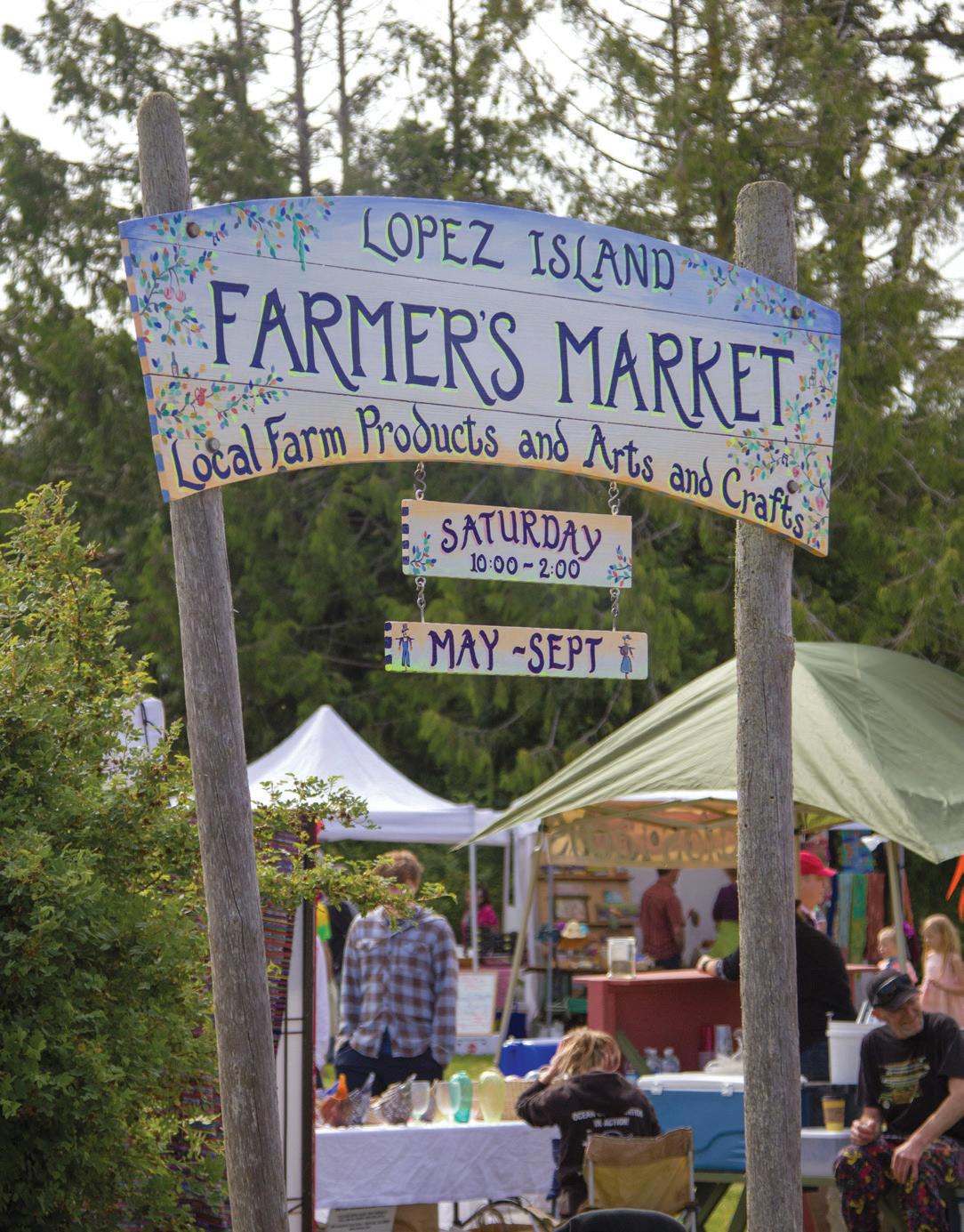
Shaw Island may be the quietest of the ferry-served San Juans, but for those drawn to solitude and subtle beauty, it’s a well-kept secret. With no galleries or bustling art walks, its creative energy flows from mossy forests, ebbing tides and a stillness that invites reflection. e Little Red Schoolhouse & Historical Museum, open by appointment, shares a charming peek into island life. ink handmade quilts, faded photographs and island-crafted keepsakes. Shaw’s not about a formal arts scene; it’s about inspiration in its rawest form. Bring a journal, a camera or just your curiosity, and let the island reboot your creative drive.
“Shaw Island may be the quietest of the ferry-served San Juans, but for those drawn to solitude and subtle beauty, it’s a well-kept secret.”



“With its misty forests and winding mountain roads, Orcas Island practically begs to be painted, carved or sculpted. Fortunately, its artists have answered the call.”

With its misty forests and winding mountain roads, Orcas Island practically begs to be painted, carved or sculpted. Fortunately, its artists have answered the call. As you roll off the ferry at Orcas Landing, you’re already on the trail of island-made ceramics, paintings and kinetic sculptures tucked into every nook and neighborhood.
Your first stop is Eastsound, the island’s walkable hub and home to a thriving arts scene. Pop into Crow Valley Gallery for carved kitchen tools, wheel-thrown pottery and island prints. Just up the street, the Wandering Soul Art Gallery is worth the detour, with woodwork and mixed-media pieces displayed in a space that feels more like a garden hideaway than a gallery.

If you time your trip right, you might catch the Orcas Artists’ Studio Tour in mid-August, when about thirty working studios open their doors to curious wanderers, or the Orcas Island Film Festival in early October, an intimate, cinephile favorite known for screening Oscar contenders before the buzz hits.
Next, head west for a one-of-a-kind experience at Orcas Island Pottery. Tucked above the cliffs with panoramic ocean views, this open-air studio feels like a magical forest out of














a storybook. Colorful ceramic works perch on driftwood shelves beneath towering trees, with eagles soaring overhead. It is open daily during spring and summer hours.
As your artful adventure continues, swing by the marina at Rosario Resort. While the historic mansion is undergoing renovation through summer 2025, you can still stroll the sculpture-dotted grounds or hike up to the WPA-era stone tower on Mount Constitution for an end-of-day dose of perspective, both visual and otherwise.
Finish your loop in Olga, a blinkand-you’ll-miss-it spot that holds one of the island’s most beloved creative hubs: Orcas Island Artworks. Housed in a former strawberry packing plant, this co-op gallery showcases everything from glazed platters to woven wall hangings, all handmade on Orcas. Lascaux Café, on-site and open ursday through Sunday, makes it easy to linger a little longer over both your latte and the local artistry.

Many island artists keep unconventional hours—this is true for all the San Juan Islands—so a little flexibility (and perhaps a quick call ahead) goes a long way. e reward? A chance to experience local art in situ, often in the artist’s home studio, surrounded by wildflowers and the scent of cedar.
























As atmospheric levels rise, how can Washington’s forests turn climate-changing carbon into trees?

Daniel O’Neil




They pale in comparison to carbon. Diamonds are solid carbon. Oil and coal are carbon, too, having originated as vegetation that took carbon from the air hundreds of millions of years ago and stored it as roots, trunks, leaves, algae. But ever since the Industrial Revolution fi red up, this carbon has returned to the atmosphere where it now poses existential threats in the form of global warming and climate change. Washington does not have many gold deposits. It does not produce diamonds, oil or coal. But the Evergreen State does grow trees exceptionally well. Its west side supports some of the most productive forests in the world. These temperate rainforests can extract excess carbon from the sky and store it as towering green for centuries, limiting the damage done by burning fossil fuels. But only if we let them.
Sequestering and storing atmospheric carbon using forests is not a radical idea. The question is why Washington doesn’t embrace the strategy of putting its forests to work capturing carbon while still producing top-quality timber.
A satellite view of Washington helps explain the state’s potential for forest-based decarbonization. When the skies clear between the ocean and the Cascade Range, a rugged, emerald landscape emerges, a stark contrast to the dry, mostly brown expanse east of the Cascades. While Washington’s arid, fireprone eastern forests do consume, and emit, carbon, the focus of carbon capture and storage resides in the temperate rainforests of the west.
With society worldwide emitting about 40 billion tons of fossil fuel-born carbon dioxide into the atmosphere each year, it’s clear that Washington’s forests alone cannot halt anthropogenic climate change. ey can, however, do their part, and they could make a significant contribution toward Washington’s goal to be net-zero in greenhouse gas emissions by 2050.





Dr. Beverly Law, professor emeritus of global change biology at Oregon State University, has spent decades advancing the science on carbon and forests. Western Washington’s forestland is some of the most carbon-rich on the planet, she said. “If you look at the carbon density, the amount of carbon in biomass per unit area of ground is higher than it is in tropical forests. So they’re really important for climate mitigation,” she said.
A study of Washington’s westside forests by Law and colleagues calculated that these woods currently hold about 826 million metric tons of carbon aboveground in trees, the equivalent of 8.26 million train carloads of coal. If left uncut until 2100, Washington’s forestland would sequester the equivalent of thirty-eight years of the state’s current annual carbon emissions.
Law’s research has also determined that by growing trees for longer on private land, and by protecting more publicly owned forestland from harvest, Washington’s forest carbon stock could double, or even triple, during this century, depending on how much public forestland was set aside.
While a no-cut policy could remove important amounts of carbon from the atmosphere, other interests are also at play in Washington’s woods: lumber and jobs, for example, but also forest resilience in the face of fire, insect, and disease pressures related to climate change. Some experts, concerned by the ballooning amount of carbon in the air and its consequences, believe it’s possible instead to have carbon-storing forests and cut them, too.

Climate-smart forestry proposes a compromise between today’s intensive logging and a scenario in which no trees are cut. It values climate-related issues—like carbon capture, retention of mature and old-growth trees, forest ecosystem resilience, reducing forestry-related emissions, and supporting rural economies—rather than a take-it-orleave-it-all approach.
When and how a forest is cut determines much of climatesmart forestry. “There’s a ton of science that says if you cut trees at a less frequent cycle, up to a certain age, you can both store more carbon and have more biomass to harvest per acre,” said Dr. Paula Swedeen, senior director of policy for Olympiabased Conservation Northwest, a nonprofit. “Our forests in Western Washington are really strong carbon sinks. Left to their own devices, they would store massive, massive amounts of carbon. So can we utilize the strength of our carbon sinks in these managed lands to store more carbon in the forest while we’re still producing wood products that we all need?”
As with all topics in forestry, the question of carbon capture potential is debated. In Washington and elsewhere, some foresters believe short rotations—cutting trees young, in thirty-five-year cycles—devour more carbon from the atmosphere than longer, say, eighty-year rotations. Short rotations are preferred by private, industrial timber companies, which own 20 percent of Washington’s total forestland, some of the most biologically productive forests in the state. The financial system in which these firms operate reaps the most return on investment from quick turnover.
Numerous experts disagree. Seth Zuckerman, executive director of the Northwest Natural Resource Group in Seattle, said the data suggests most carbon uptake occurs from around age 30 to age 80, hence the climate-smart logic of longer rotations.
“The shorter your rotation, the longer the time that the forestland spends not being at its peak efficiency of removing carbon from the air,” Zuckerman said. “So you’re basically forfeiting the first five or ten years of your rotation while you, in effect, rebuild your solar panels that are going to pull the carbon out of the air. If you do that on a forty-year rotation, you’re spending a quarter of your time in that rebuilding phase. If you do it on an eighty-year rotation, you’re only spending an eighth of the time in that rebuilding phase, so it stands to reason that you’re not going to be as efficient at carbon sequestration in a short rotation as with a long rotation.”
Computer modeling and other analyses have shown that longer-rotation forestry offers greater carbon sequestration and storage, increased timber volume and other benefits like forest ecosystem resilience and expanded biodiversity and wildlife habitat. The question becomes how to compensate for lost revenue while private landowners extend rotations. Transitioning small increments of land over time, or slowly increasing the rotation time from forty years to fifty years,
are two options. Thinning forests, especially the 44 percent of Washington’s forestland owned by the federal government, could also help fill the void while restoring overgrown woods to greater health and complexity.
Across active timberlands in Western Washington, clearcutting—or, in industry terms, regeneration harvest—remains the standard method for harvesting trees. Industrial owners consider the removal of an entire block of forest as the most efficient and therefore economical practice. Washington’s Department of Natural Resources, or DNR, also employs regeneration harvest on the 2 million acres it manages, but to a lesser extent. Besides its consequences for soil, streams and wildlife, clearcutting and forestry in general carry a carbon toll.
Research by Law found that 100 years after harvest, 65 percent of the wood had returned to the atmosphere as carbon, with the remaining carbon divided between landfills and longlived wood products. “We call it ‘slow in, fast out,’” Law said. “It takes a long time for the carbon to get into the trees to be held there. But when you cut them, a lot of it goes to the atmosphere relatively quickly.”
Logging debris like treetops and branches decompose or are burned, emitting carbon into the air. Mills burn sawdust and scraps for energy and heat, which releases more carbon. Transportation in forestry emits comparatively little. According to Swedeen, up to 40 percent of the harvested wood does not become a product, and wood products themselves decay over time in landfills. The amount of carbon stored in wood products is about 10 percent of the total amount of carbon stored in the forest, she added.
By removing all vegetation and disturbing the forest floor, clearcutting and the large-scale variable retention cuts practiced by DNR account for extra carbon release. Research by Dr. John Talberth, president and senior economist at the Port Townsend-based Center for Sustainable Economy and codirector of the Forest Carbon Coalition, shows that for ten to fifteen years after a clearcut, the forest ecosystem emits more carbon than it captures.
“If you had a different model where you did individual tree selection or patch cuts, what’s called variable density thinning, where you leave the canopy intact, you don’t have those carbon sequestration dead zones,” Talberth said. “That’s where climate-smart forestry comes in. It’s a way to get the wood we need while leaving the forest canopy intact.”
With 10 percent of Washington’s total forestland under its control, DNR works under a mandate to produce revenue from those trust land forests, but also to respect other values, including decarbonization, to meet the state’s emissions goals. In line with election promises, DNR’s new commissioner has paused logging in mature forests to evaluate, among other things, their carbon-capturing ability.
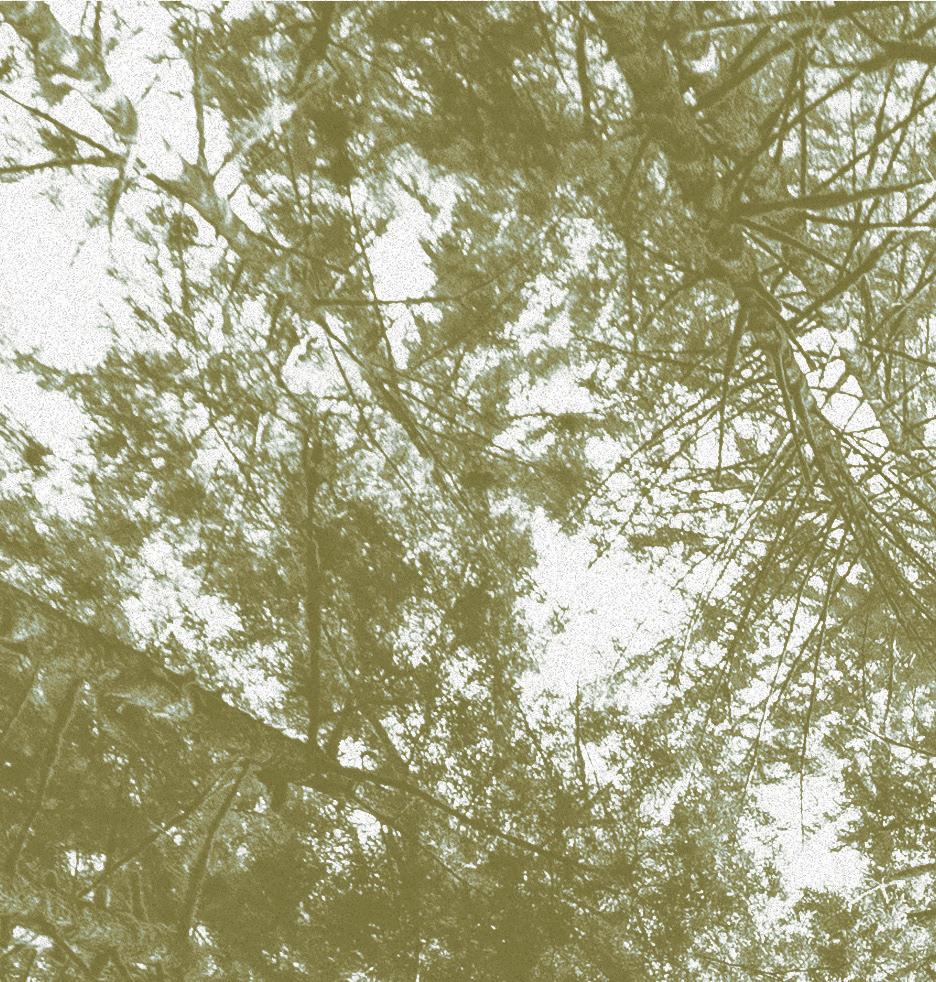




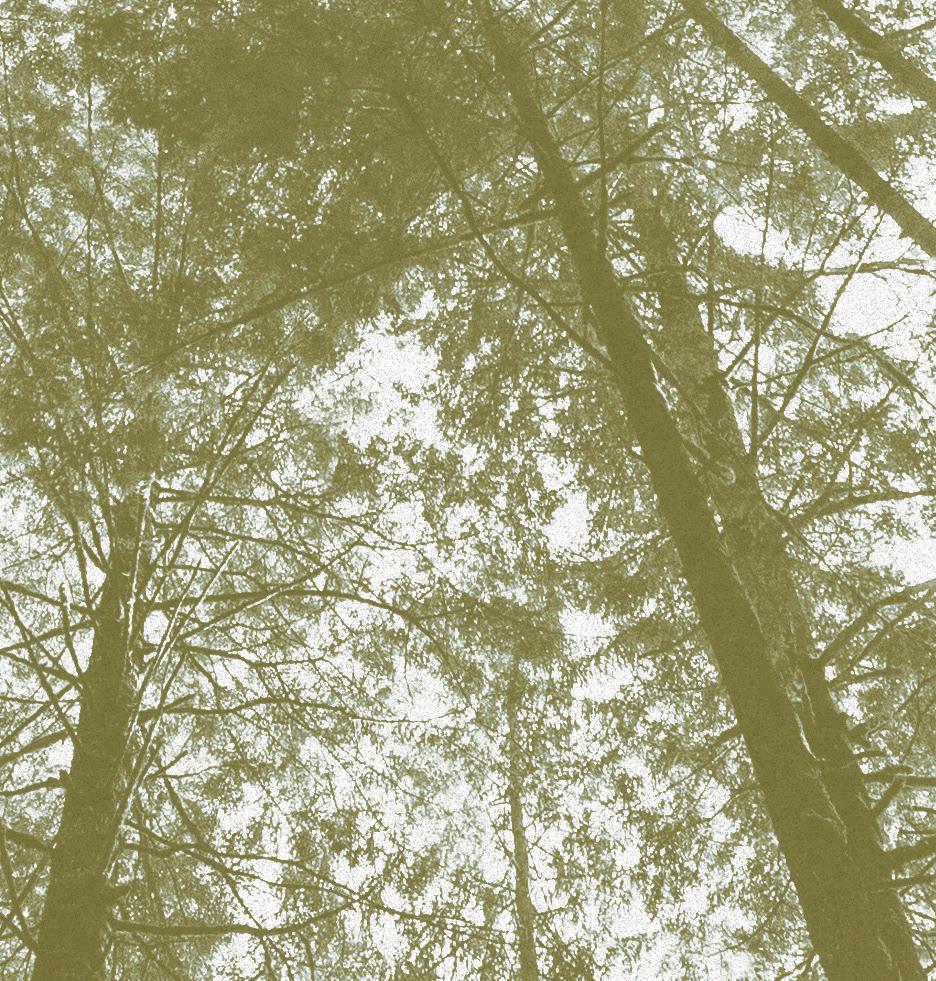


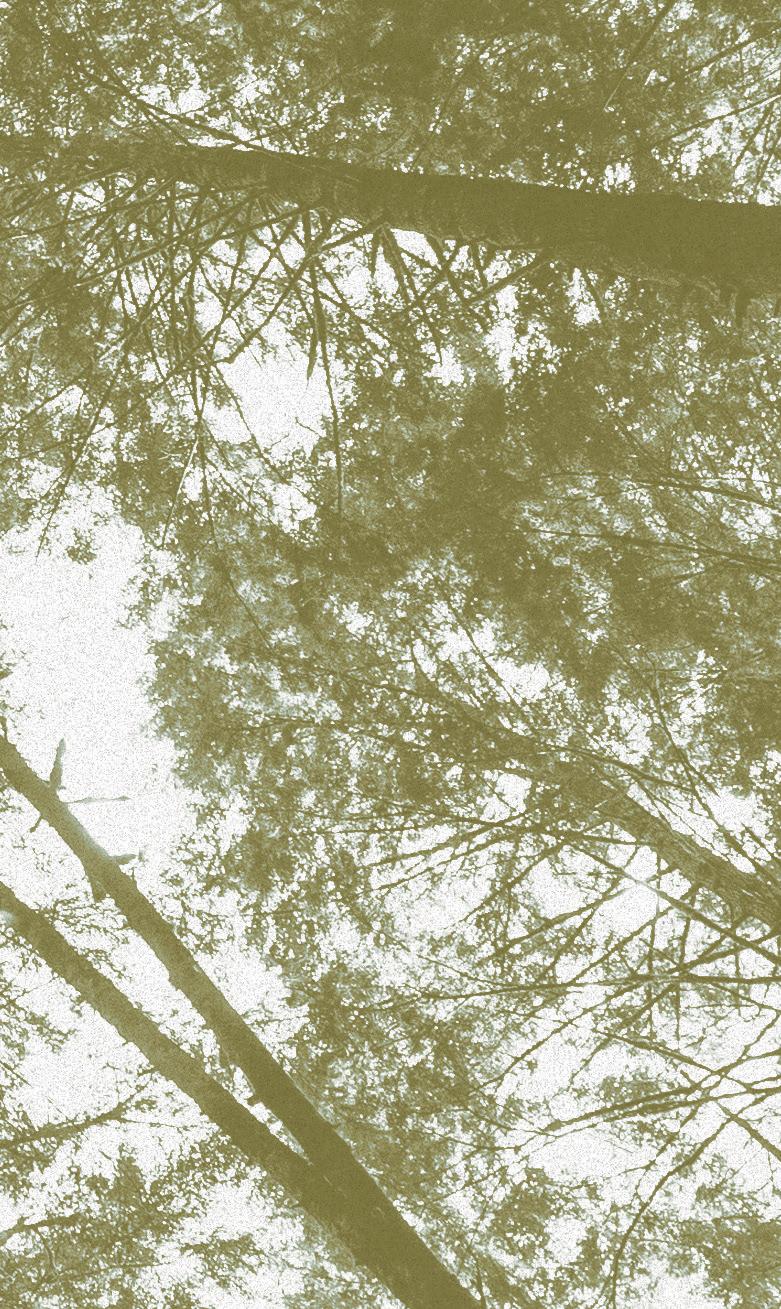





























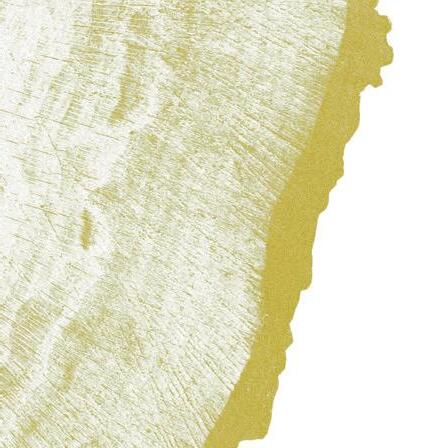







“Our forests in Western Washington are really strong carbon sinks. Left to their own devices, they would store massive, massive amounts of carbon. So can we utilize the strength of our carbon sinks in these managed lands to store more carbon in the forest while we’re still producing wood products that we all need?”



— Dr. Paula Swedeen, Conservation Northwest senior director of policy

In search of ways for the state’s forests to sequester and store as much carbon as possible, Swedeen and colleagues recently ran some sophisticated computer models using DNR data. She found that by reducing the amount of acres cut, and increasing the amount of thinning, over time DNR could transition from its average fifty-year rotations to seventy- to eighty-year rotations. is method would retain twice as much carbon (in the forest ecosystem and in wood products) while maintaining the same amount of timber volume as harvested today, and create jobs because thinning requires additional labor.


hoping that DNR would incorporate our findings or take the fact that our findings point in a certain direction when they do their next sustainable harvest calculation, to have an option for increasing rotation lengths on their regular managed lands.”
DNR Uplands Silviculture Program manager Calvin Ohlson-Kiehn believes his agency is already trapping large amounts of carbon. Half of the forestland managed by DNR is protected from harvest, and the agency says the carbon uptake of those forests offsets the emissions from logging on the other 1 million acres.
“ at’s pretty exciting to me, to know that we could make much more use of the potential carbon sinks that we have in our Western Washington forests than we are now, and we can do it without sacrificing the jobs,” she said. “We’re
Ohlson-Kiehn considers DNR forestry one of the most responsible in the world. “We’ve always wanted to maximize volume sustainably, and when you maximize volume, you’re pretty well aligned with maximizing carbon sequestration,”
he said. “I do think that in Western Washington there are ways that we could make minor adjustments to our silvicultural practices, like planting slightly different proportions of different species and managing stands at different densities. But in my opinion, we’re probably 80 or 85 percent of the way there.”
Alittle over 35 percent of Washington’s forestland is privately owned, and more than half of this, some 4.5 million acres, is owned by industrial timber companies who are foremost interested in profit. Private landowners, especially industry, will need to contribute if Washington wants to reach net-zero emissions by 2050.
For decades now the carbon market concept has proposed a financial mechanism for protecting the atmosphere and climate from carbon overload. Emitters of greenhouse gas emissions can buy credits on the market that pay someone else to, among other things, grow trees for carbon capture. Washington has no full-scale carbon market of its own, but its forestland owners now have access to California’s robust version.
While the carbon market offers the financial incentives needed to entice industrial timberland owners, few in Washington are responding. Port Blakely, a timber company based in Seattle, however, has dedicated 10,000 acres in Washington to the carbon market—offsets will pay for longer rotations. Ecotrust Forest Management, a climate-smart investment firm with forestland in Washington, works with the carbon market and has collaborated with companies like Microsoft and Meta to offset emissions by growing forests. (Both timber companies declined to comment for this article.)
One limiting factor of the carbon market is accountability. Fossil fuel emissions are often offset by forests, but timber harvest incurs its own emissions, which are then offset by other working forests—the carbon buck only gets passed. After harvest, landowners can get offset money for replanting on the same site, despite the quantity of carbon released by converting that forest into wood products.
Besides these loopholes, forestry’s own greenhouse gas emissions are not fully calculated in Washington. A recent paper co-authored by Talberth documented that Washington’s emissions from logging would be the number one or number two source in the state if they were properly counted. According to his calculations, DNR-managed lands fall in last place for net carbon sequestration in Washington’s forests, just behind industry.
Once again, forestry experts remain divided. “ is is where the science gets complicated and there isn’t perfect agreement,” DNR’s Ohlson-Kiehn said. “When you harvest those wood products, the majority of them go into building materials where they are still sequestered, and then you grow more. Obviously there are some emissions, but
essentially we are sequestering so much more carbon than we will ever harvest.”
While DNR forestry is linked to public policy, industrial forestry responds to other, more financial, incentives. Several options exist, including taxation. Talberth and others have proposed the framework for updated tax structures that could bring more industrial timberland owners in line with Washington’s emissions goals.
“If we put a forest carbon tax on the emissions from industrial logging, but give generous exemptions and credits for doing climate-smart practices, that would help catalyze the transition we need on private lands,” Talberth said.
New taxes are an option, albeit a politically challenging one in a state where “Big Timber” maintains a juggernaut presence in policy making. Modifying existing taxes, modernizing them, in a sense, to incentivize climate-smart forestry might be more palatable in Olympia.
Zuckerman proposes changes to the timber tax that is already collected when trees are harvested. “If you wanted to incentivize longer rotations, and incentivize thinning along the way to raising older forests, you could change that structure,” he said. “You could lower the tax rate for those who conduct a partial cut, and you could raise the tax rate on those who do a regeneration cut and have the rate be higher the younger the trees are when you cut them.” Higher taxes on status-quo forestry could also support a rebate for those who thin because of the additional labor required for thinning, he added.
Finally, on one point everyone agrees: Massive wildfires have become a major source of Washington’s carbon emissions in recent years. Agencies and private landowners, especially on the east side of the state, are now engaged in wildfire mitigation efforts to build forests’ resilience. Even on the west side, drought has become a limiting factor in forest health. Both threats are exacerbated by emissions-related climate change. As the climate crisis grows, forests are having an ever harder time helping stop it.
Addressing the emissions and climate emergencies will take a global effort. Washington cannot save the planet, but it can pull more than its fair share of carbon from the atmosphere, and reduce current emissions, by modernizing its forestry practices, taxes and regulations. Just like trees, forestry and policy can evolve and adapt to new situations.
“Right now, in my view, we’re under-encouraging the sequestration of carbon, the stability of rural communities, the production of high-value, high-quality timber products,” Zuckerman said. “ ere’s a lot of room for improvement. We’re overweighting the short-term production of timber and cash, and undervaluing the forest’s ability to sequester carbon. It’s up to us as a state and as a society to decide what mix of those different possible outputs we want to encourage.”


written
ONE OF THE highlights of a visit to Friday Harbor is the San Juan Islands Museum of Art (SJIMA). A er gliding o the ferry and winding through the small town seaport, you can’t miss the modern structure where sun glints o a luminous glass and steel atrium.
The small but stately museum brings in rotating exhibitions of fine visual art including paintings, drawings, sculpture and photography from local and global artists. On view now through September 15 is Shapeshi ers, a landmark exhibition that celebrates contemporary Northwest Coast Indigenous art through the lens of transformation.
Centered on Raven, a powerful figure of change, the show features thirty-two Pacific Northwest Coast tribal artists from Washington and British Columbia—all exploring identity, resilience and renewal through their work. Art forms span cedar carvings and bronze sculptures to basketry and serigraphs.

In addition to selections from SJIMA’s First Nation Artists Collection, you’ll find work by some of the Northwest’s most renowned Indigenous artists, including Christian White, Rande Cook, Susan Point, Tim Paul, Gordon Dick and Dan Friday. For more information and to listen to interviews with the artists, visit www.sjima.org

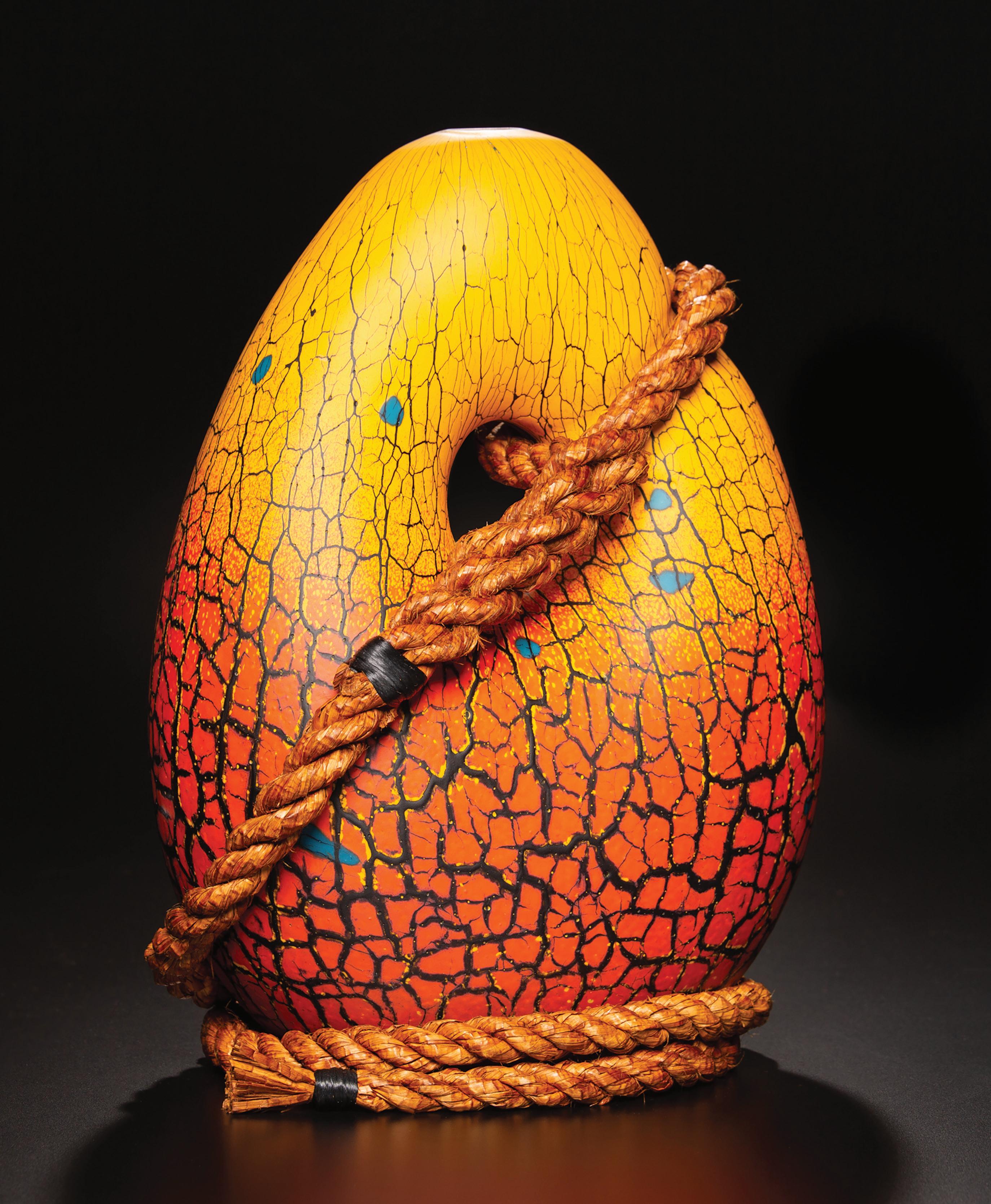
Dan Friday, Sxwo’le Reefnet Anchor. A Lummi Nation member, Friday is a contemporary glass artist and often draws from his Coastal Salish heritage when creating his vibrant sculptural pieces. He was also a contestant on the Netflix reality competition series Blown Away AT FAR LEFT Susan Point, Bluey Lake A member of the Musqueam First Nation, Point is renowned for her contemporary interpretations of traditional Coast Salish art. Her works span across mediums, including sculpture, prints and public art installations.

Christian White, Raven with Clamshell
A renowned Haida artist, White is known for his intricate argillite carvings, totem poles and paintings.
AT FAR RIGHT
TOP ROW, LEFT TO RIGHT
Tom Hunt, Sun. Hailing from a family of prom inent artists and the Kwakwaka’wakw First Nation, Hunt is known for his solid cedar masks, contemporary wood carvings and totem poles.
Richard Hunt, Welcome Figure. A Canadian art ist from the Kwakwa ka’wakw First Nation, Hunt is celebrated for his work in traditional Northwest Coast wood carvings, sculptures and masks.
MIDDLE ROW, LEFT TO RIGHT
Susan Point, Symphony of Butterflies
Christian White, Chief of the Sea
Tim Paul, Nas Returning the Moon. A Hesquiaht/ Nuu‑chah‑nulth master carver and cultural storyteller, Paul is renowned for his totem poles, masks, silkscreen prints and sculptures. He’s also a leader in language preservation and coastal environ mental advocacy.
BOTTOM ROW, LEFT TO RIGHT
Rande Cook, Beyond the Mask. An Aborig inal artist from the Kwakwaka’wakw First Nation on Cormorant Island, Cook’s work spans wood carving, jewelry, glass and printmaking—blending traditional Northwest Coast themes with con temporary techniques and materials.
The Shapeshifters ex hibit will be on display through September 15 at the San Juan Islands Museum of Art in Friday Harbor.






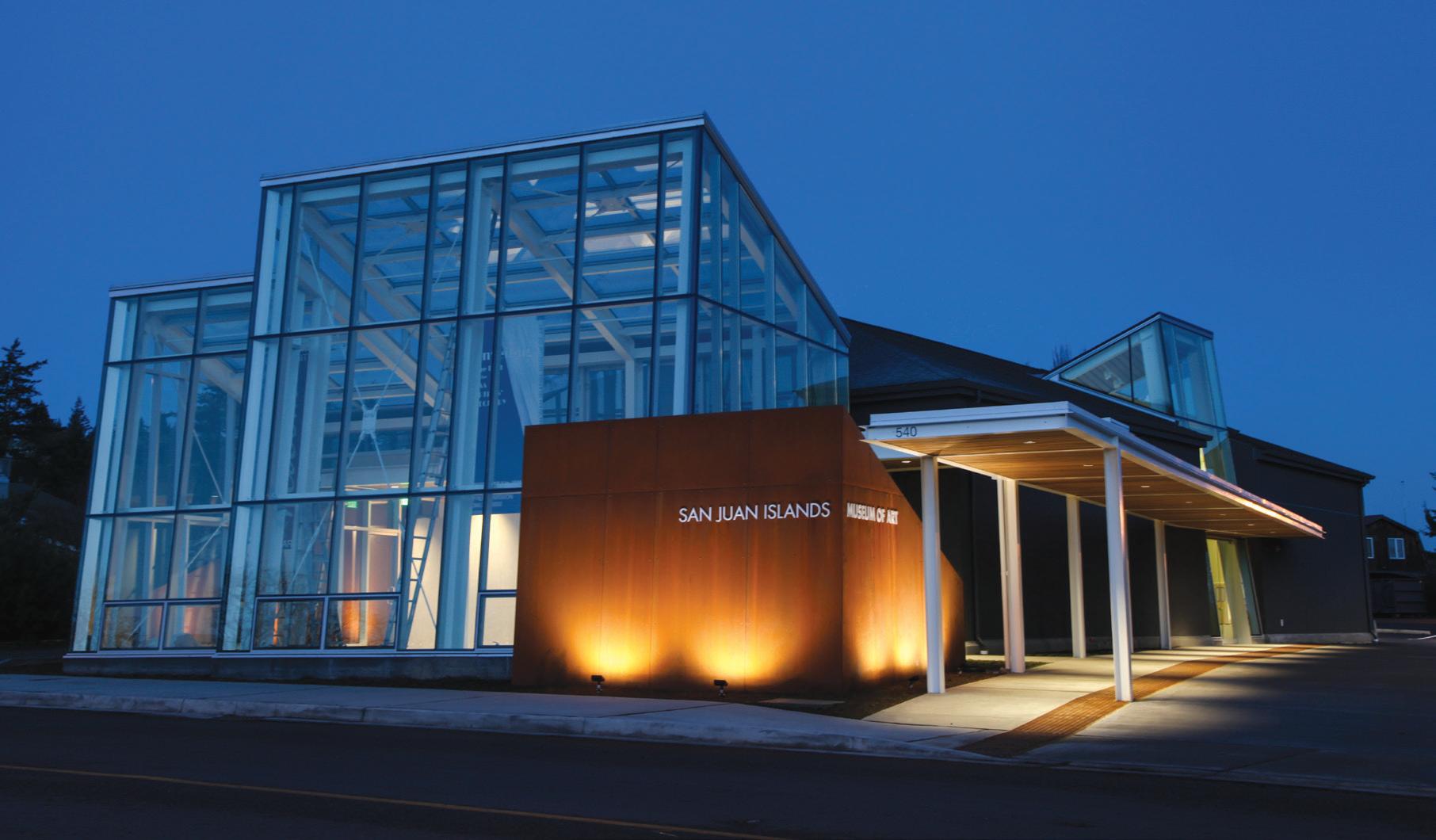

TRAVEL SPOTLIGHT 68
ADVENTURE 69
LODGING 72
TRIP PLANNER 74

NORTHWEST DESTINATION 82








































Hall of Mosses Trail and others transport you to a lush other world
written by Joni Kabana
IT’S THE END of summer, and you’ve had your fill of 10 p.m. sunsets, river skinny-dipping and ice cream cones that have to be eaten quickly before they run down your arm. You’re hot and bothered and not quite ready for the rains to return, but your heart is set on finding some kind of solace from the relentless sun as you make your way across town, a prairie or the high desert. Where to go? Try a lush forestland, with trees covered in moss that make you feel like you’ve been transported to another mysterious Gothic world.

The Hoh Rain Forest, located on the west side of Olympic National Park, is a sight to behold, especially if you want to trade hot and sticky for cool and comforting. Persistent winter rains ensure this forest retains moisture and dew drops all year round. Take your time as you let your imagination run wild during a slow stroll among the magical pathways.
The Hall of Mosses Trail is a nice out-and-back, 0.8-mile trek near the visitor center that is full of old-growth trees and has a large maple tree grove draped in moss. Tall ferns line the path. Lush green moss covers almost every living thing, which makes visiting humans feel as though they are part of the eco-forest, not simply observers.
Other trails, such as the 1.2-mile Spruce Nature Trail and the extensive Hoh River Trail are located nearby and serve for further exploration of the region. Permits are required for backpacking, and reservations are a must for camping. Leave your phone, camera and pets (no dogs allowed) at home, and let yourself become one with nature. This place does that for you, and a whole lot more.




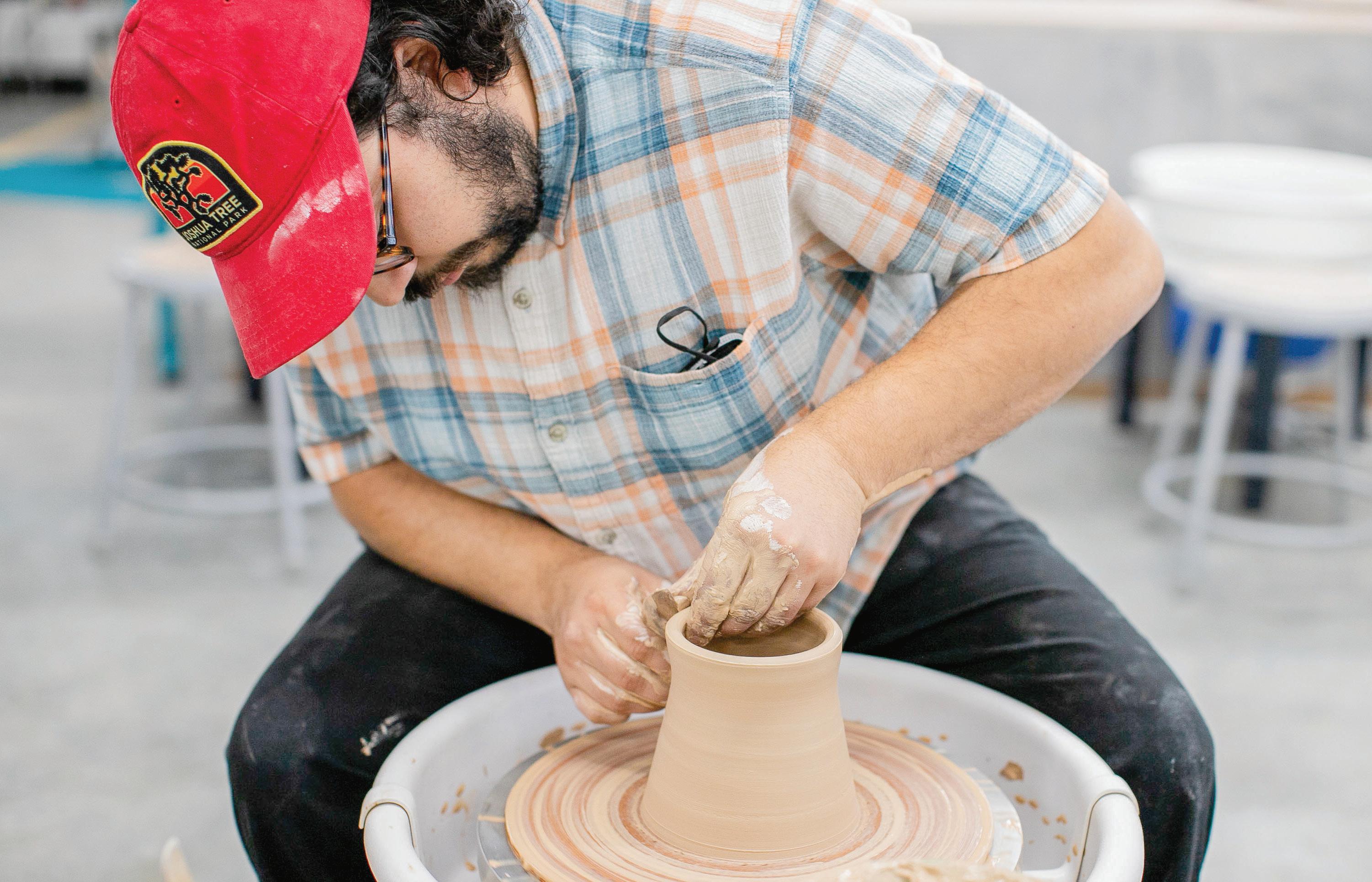
Blow glass, throw po ery, blend wine or rock out with skilled local artists written by Cathy Carroll
IT’S ONE THING to take in great works of art and cra , but there’s no be er way to fully connect with it than to try your hand at it. Tap into your creative power. Explore portrait drawing with a live model. Take to the stage and channel your inner Jimi Hendrix. Feel the smooth texture of wet clay in your hands as you shape it into your next favorite co ee cup. Plunge foot-long tweezers into a glob of molten glass to form the design of a blown-glass bowl. Dive into oenological and culinary arts, cra ing your own wine blend or a summery nectarine and shiso soup with chive flowers. The state is packed with experts in every medium who generously share their talents and delight in developing yours. Discover your next artistic outlet here.
Shape clay by hand or use a pottery wheel to craft cups and bowls in a range of classes and workshops at Reclaim Clay Collective, a community pottery and art studio led by POC, queer and women artists in the historic Tsue Chong fortune cookie factory in Seattle’s ChinatownInternational District.
• Reclaim Clay Collective: www.reclaimclay.com
Feel the glow of white-hot, 2,100-degree heat as you work with an artist to create a glass art piece. Wield a blowpipe, molten glass on its end, as you smooth and shape it. Select colors and use steel tools to pinch and twist swirling patterns into malleable mass. Begin with an hourlong, one-on-one experience or multiple or longer sessions for more in-depth learning.
• Sea le Glassblowing Studio: www.sea leglassblowing.com
• Tacoma Glassblowing Studio: www.tacoma glassblowing.com
• Pra Fine Arts Center: www.pra .org
Channel your
FROM

A
Place Market
you
The Seattle Glassblowing
Explore Pike Place Market armed with expert guidance and insider secrets from chef Traci Calderon as she leads you to her favorite spots at the legendary market, with some delicious sips and nibbles along the way. Procure seasonal ingredients with a dash of history and stories of this landmark. Then head to Calderon’s Atrium Kitchen, a gleaming, modern commercial kitchen at the famed Seattle market. There, the chef will lead you and your group in creating a lunch or dinner menu that you cook together with the freshly sourced, local ingredients.
Get in touch with your olfactory skills and palate as experts guide you in creating your own red wine blend at the Winemaker for a Day workshops at Chateau Ste. Michelle in Woodinville. Taste varietals and evaluate their sweet, acidic and bitter qualities as you craft a libation as balanced and complex as yourself. The ninety-minute sessions, Fridays through Sundays at 11 a.m., require reservations.
Immerse yourself in a culinary experience paired with a satisfying sense of community at The Pantry in Seattle. In classes such as the three-hour Summer Fruit Harvest, chef Bruce Naftaly—widely regarded as the godfather of Northwest cuisine and a pioneer of Seattle’s farm-to-table movement—guides you
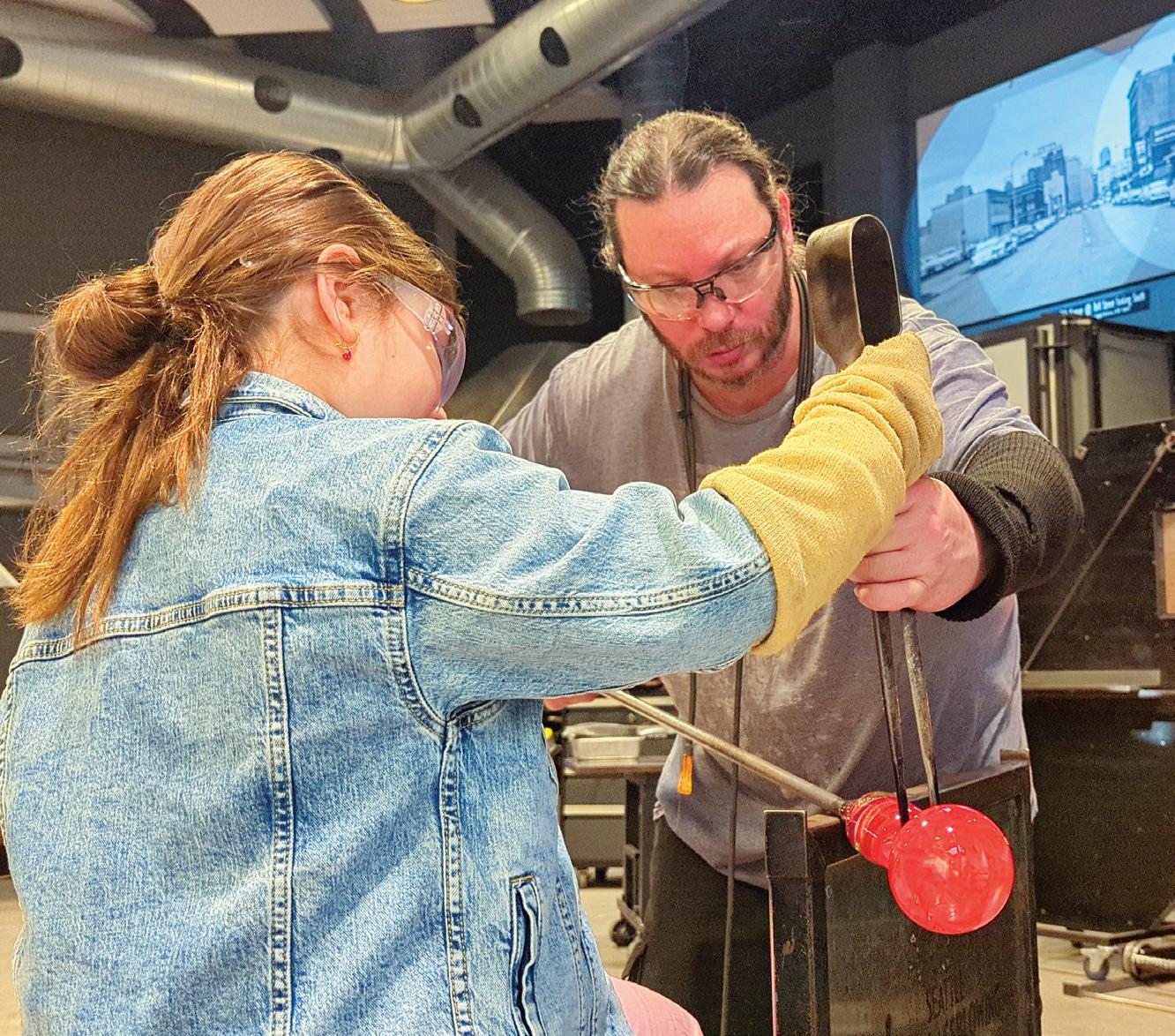


Immerse yourself in a culinary experience paired with a satisfying sense of community at The Pantry in Seattle.
In classes such as the threehour Summer Fruit Harvest, chef
Bruce Naftaly guides you in creative new savory and sweet ways to highlight local bounty.
in creative new savory and sweet ways to highlight local bounty. Think: a menu of poached steelhead with creamy blueberry sauce, and grilled stone fruits with melon, summer greens, pickled cherries and plum dill vinaigrette. End with a brandied raspberry fool, the Northwest version of a classic English dessert of crushed fruit folded into whipped cream or custard.
• Atrium Kitchen: www.atriumkitchenpikeplace.com
• Chateau Ste. Michelle: www.ste-michelle.com/visit-us/ experiences/learning-with-leisure
• The Pantry: www.thepantryseattle.com
From painting, drawing and printmaking to welding, woodworking, blacksmithing, glassblowing and jewelry making, the nonprofit Pratt Fine Arts Center offers access to the transformative power of artistic expression. Classes and workshops range from a few hours to multiple weeks and accommodate complete beginners, whether you’re wielding a sketch pad or blow torch.
• Pratt Fine Arts Center: www.pratt.org
It’s never too late—or even too early—to be a rock star. School of Rock teaches adults as well as kids how to launch or improve their music skills. The program focuses on music skills for live performance.
The adult program includes one weekly private music lesson and a weekly group rehearsal. You’re placed in a band of fellow adults and then assigned songs to develop key musical skills. Then you take the stage to play live at a show in your town. Schools are in Seattle, Bellevue, Issaquah and Vancouver.
• School of Rock: www.schoolofrock.com
written by Lauren Kramer
THIS MAJESTIC INN sits on the banks of the Wenatchee River and at the foothills of the mountains. Stately aspen trees shade its meticulously landscaped gardens, home to Prince, a peacock who arrived unexpectedly and adopted the inn, and a flock of chickens whose eggs are poached for morning breakfasts. Built in 1917, the 9,000-square-foot mansion was lovingly restored by Julia and Ludger Szmania in 2014, when the Sea le couple le big city life for a peaceful, rural alternative. Today they grow merlot, sangiovese and syrah grapes in Cashmere, make a wonderful assortment of wine and run their inn as a classy Wenatchee bed-and-breakfast where no detail is overlooked. Guests can watch the antics of a pair of bald eagles who nest on the property, roam and pick cherries from the neighboring cherry orchard and visit Stutzman Ranch, a u-pick apple, cherry, pluot, peach and nectarine orchard across the road.
1611 LOVE LANE WENATCHEE www.warmspringsinn.com







The inn has an outdoor pickleball court and offers afternoon wine tastings. At night guests can sink beneath the bubbles of a large hot tub overlooking the Wenatchee River.
The inn is furnished with an eclectic mix of old and new that blends seamlessly, creating charming interiors that reflect its long history but are unconfined by age. Guests gather in the sunlit riverfront lounge for breakfast and afternoon wine tastings featuring Warm Springs’ wines. The large outdoor deck is the perfect place to bask in the sunshine and watch the river’s current flow.
The six bedrooms are spacious and beautifully decorated. All feature private bathrooms, soft linens and large windows overlooking the cherry orchard, garden and river. Most have in-room tea and coffee-making facilities, refrigerators, flat-screen televisions, robes and slippers.
Breakfasts are a decadent affair presided over by Ludger, who was executive chef at many Hilton and Four Seasons hotels before opening Szmania’s restaurants in Kirkland and Seattle’s Magnolia neighborhood. He ran those until 2014, when the couple moved to Chelan County. Ludger’s menu changes daily, but his magical summer breakfasts include a fruity appetizer, a sorbet amuse-bouche made with local fruit and an egg-based entrée featuring the eggs of the contended chickens who peck at the grass just below the kitchen.
The 108-year-old inn began as a family home in 1917 and became a sanitarium for infirm patients after World War I. Over the 1940s and ’50s, it changed ownership many times, at one time becoming a horse ranch where Arabian horses were shown and bred. By 1991, Warm Springs Inn was established, and when the Szmanias purchased it in 2014, they renovated and updated the property, adding a wine tasting room. AT LEFT, FROM TOP The Warm Springs Inn deck for summer and fall lounging. Prince, the majestic peacock at the inn. A cozy and classical room at the inn. Breakfasts can be as ornate as the inn itself.
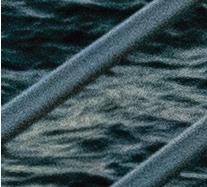













Ryn Pfeuffer

All of the Emerald City’s charm with less competition written by


SURE, AUGUST IN SEATTLE is a showstopper. The sun sticks around until 8 p.m. or so, patios fill up and the whole city seems to be on the move. But September? That’s when things start to feel just right. You can finally get that last-minute dinner reservation, catch the ferry without multihour waits and hike popular trails without constantly stepping aside. Farmers markets are teeming with late-summer produce. Wineries are just waking up for harvest. Sunsets se le down behind the Olympic Mountains. It all feels like a quiet reward for sticking around. This season still resembles summer, but summer without the elbows.




If you’re planning a weekend in town, September’s your sweet spot.

Ease into your Seattle weekend by checking in at The Edgewater Hotel, the city’s only over-water stay. Hugging Elliott Bay, this boutique hotel has an impressive rock résumé. The Beatles famously fished from their suite window here in 1964, and music lovers can still book the Beatles Suite or the Pearl Jam Suite, the latter curated with input from the band themselves. If you can, splurge on an Over Water King with a balcony for a cozy fireplace and front-row seats to ferries cruising through Puget Sound. At some point during your stay, carve out time for a sunset cocktail at Six Seven, the hotel’s chic waterfront restaurant.
Once you’ve dropped your bags, lace up your walking shoes and head out to explore Seattle’s reimagined waterfront, just a quick amble from the hotel. The new Overlook Walk connects the city’s bustling core with the bay via an elevated park offering panoramic views and top-notch people-watching. Pop into the Seattle Aquarium’s shiny new pavilion, and then head to Pier 58, where the playground is pure kid bliss—and yes, it’s totally okay if you play, too.
If your visit lines up, catch a local event: Africatown Soul on the Water (August 16) brings music and Black-owned vendors to Pier 62, Oodalalee Concerts (September 13-27) fill the air with open-air beats, and Salmon Homecoming (September 20) celebrates Indigenous culture with dance, storytelling and community connection.
Later, head up to Pike Place Market. Then, settle in at Old Stove Brewing Co., a local favorite celebrated for its rich, velvety dark lagers and cult-favorite yuzu teriyaki sticky wings. If you can, grab a seat on their sunny patio—these tables with views of Elliott Bay disappear fast.
Wind down your day with dinner at Matt’s in the Market, a beloved spot since 1991 in the Corner Building. Reservations are highly recommended, though you might luck into a bar seat during lunch. Request a window seat overlooking the market’s iconic sign. Whether you opt for clams, mussels, oysters, salmon, scallops or octopus, the fish and shellfish (sourced from Pike Place Market) are stellar. It’s the kind of meal that always feels special and makes you fall a little harder for Seattle.
Once you’ve dropped your bags, lace up your walking shoes and head out to explore Seattle’s reimagined waterfront, just a quick amble from the hotel.
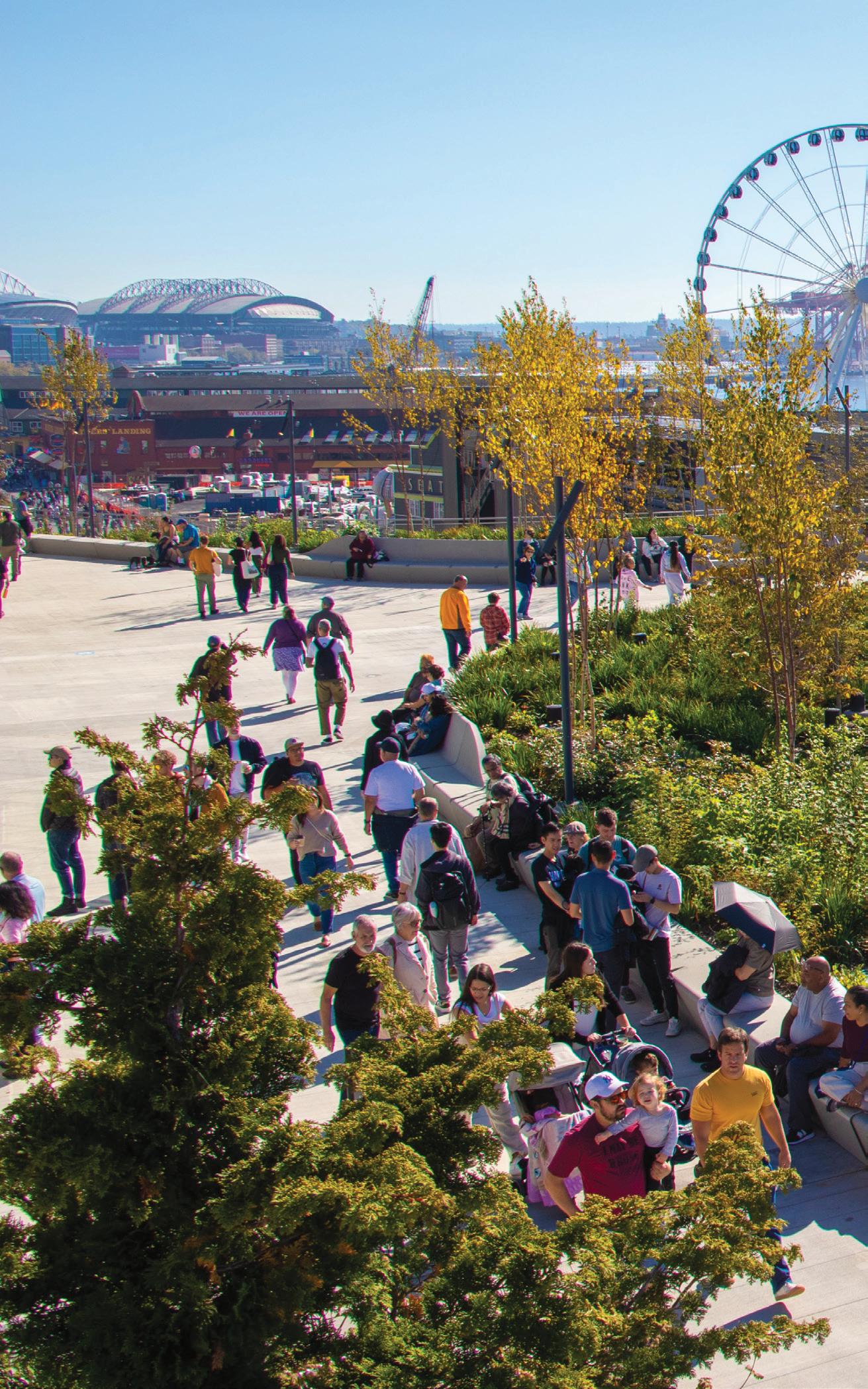

CLOCKWISE FROM TOP The new Overlook Walk is a beautiful public works project that showcases the Puget Sound. Matt’s in the Market is a classic spot for lunch or dinner overlooking Pike Place Market. A welcome and typical sight at Pike Place Market. Old Stove Brewing’s deck is a nice pairing of seasonals with scenery.



Start your morning at Le Panier. This locals’ go-to for French pastries has run on butter and obsession with flaky perfection since 1983. Buttery croissants, macarons and a mighty fine chausson aux pommes keep regulars coming back. The warm, delicate apple turnover might ruin you for all others. Pair it with a Caffè Umbria coffee to go for the perfect morning pick-me-up.
Next, wander two blocks down to DeLaurenti Food & Wine, a gourmet institution since 1946. This isn’t your average market deli. You’ll find imported cheeses, Pacific Northwest charcuterie and a beer and wine selection that’ll make choosing your favorite a delicious challenge (with plenty of nonalcoholic options, too).
Let the staff help you pick out a bottle and build a picnic-ready spread—you’ll want it later for the water.
By midday, make your way to Pier 56 for an hour-and-a-half sail with Sailing Seattle aboard a 70-foot ocean yacht. These intimate, BYOB-friendly cruises welcome all ages and offer a breezy front-row seat to Seattle’s skyline from the water. If you’re lucky, you might catch sight of an orca. (Insider tip: If you’re wooing
someone or just want a romantic sunset setting, the two-hour Sunset Sail is a worthy upgrade.)
After a quick refresh (and perhaps a nap), head to The Lounge at Canlis. With views of Lake Union and the Cascade Mountains, it’s Seattle’s most iconic fine dining address. While the formal dining room is reservation-only, the bar and lounge are open to walk-ins and offer a more laid-back way to experience Canlis magic. Sip a Zefira’s Delight—a citrusy cocktail with Saigon Baigur gin and pandan. The Canlis Salad, unchanged since the 1950s, is a timeless classic for good reason. And the Wagyu steak frites? This decadent dish nails casual elegance.
If you’re not quite ready to call it a night, take a short drive to Kerry Park. This tiny sliver of Queen Anne gives folks the full cinematic sweep of Seattle: Space Needle in the foreground, Mount Rainier in the distance and Puget Sound catching the last of the sunset glow. It’s a classic, and for good reason. Just don’t forget your camera—or your patience. Parking is a squeeze, but the view is unbeatable.
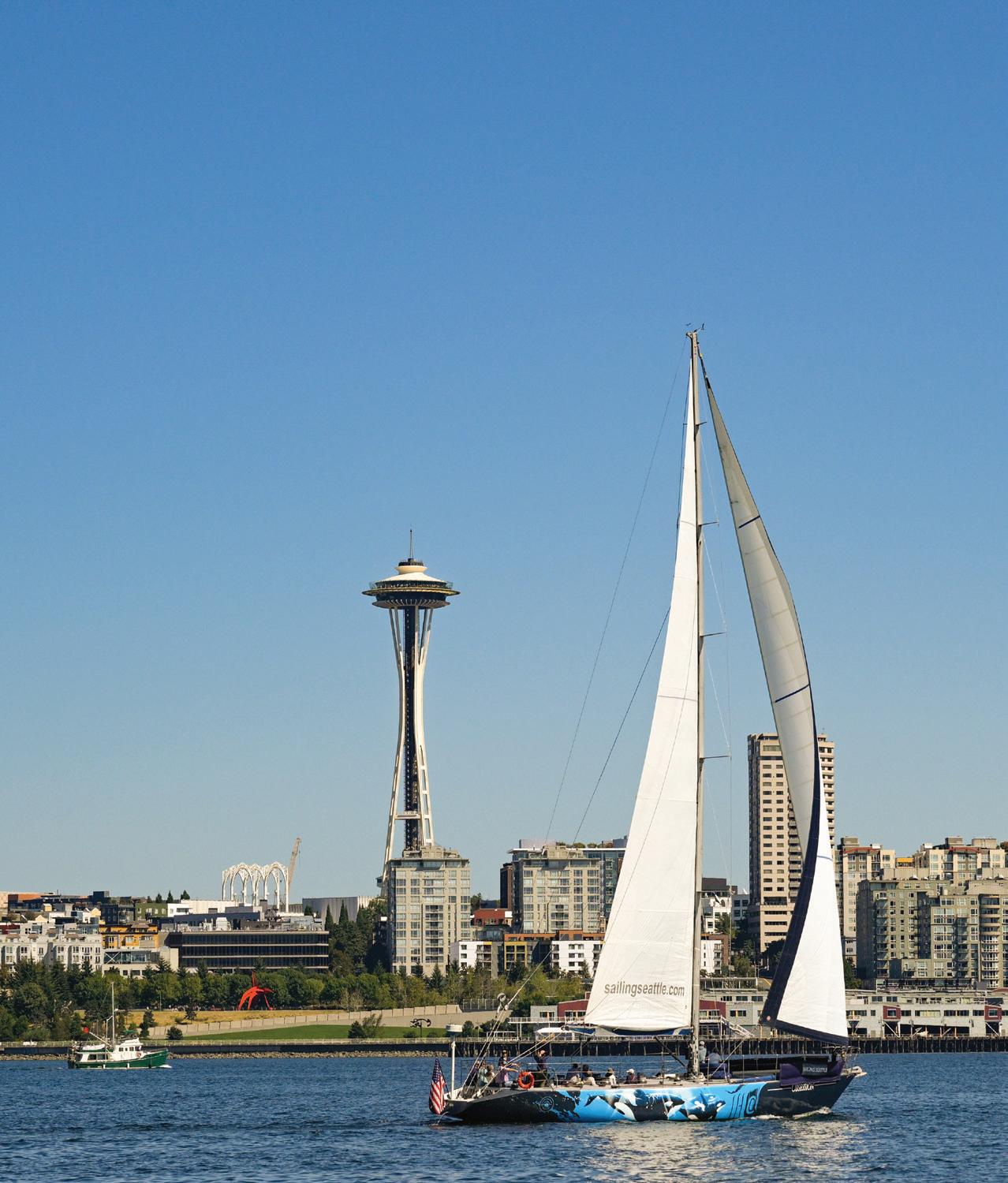








EAT
Canlis www.canlis.com
DeLaurenti www.delaurenti.com
Fuji Bakery www.fujibakeryinc.com
Le Panier www.lepanier.com
Matt’s in the Market www.mattsinthemarket.com
Old Stove Brewing Co. www.oldstove.com/pikeplace
Six Seven Restaurant www.edgewaterhotel.com/ seattle-six-seven-restaurant
The Garrison www.thegarrisonseattle.com
The Edgewater Hotel www.edgewaterhotel.com
PLAY Ballard Locks www.ballardlocks.org
Discovery Park www.seattle.gov/x63689
Duwamish Longhouse and Cultural Center www.duwamishtribe.org/ longhouse
Sailing Seattle www.sailingseattle.com
Seattle Aquarium www.seattleaquarium.org
Seattle Waterfront www.seattlewaterfront.org

On your final morning, begin with a detour to Fuji Bakery in Interbay, where French patisserie techniques meet Japanese flavors. The signature Crunchy Cream Malasada, a custardfilled doughnut coated in crispy cornflakes, is a local legend. Craving something savory? Go for the Beef Curry Bun (Curry Pan), a golden, panko-crusted pocket filled with rich Angus beef curry. It’s the kind of breakfast that feels indulgent—and 100 percent worth it.

Next, slip away to Discovery Park—Seattle’s biggest and arguably most peaceful green space. The trail to the West Point Lighthouse is a local favorite, with quiet forest paths that open up to spectacular views of Puget Sound, the Olympics and Mount Rainier when the skies cooperate. Down by the water, it’s all smooth stones, driftwood sculptures and the occasional seal bobbing in the waves. If you’re lucky, you might catch a river otter weaving between the rocks near North Beach. Early mornings and just after sunrise are pretty much magic. (Heads up: Pups aren’t allowed on the beach.)
For lunch, swing by Chinook’s at Salmon Bay, a laid-back seafood spot overlooking the docks at Fishermen’s Terminal. Expect a solid lineup of fresh local catches—halibut fish and chips, clam chowder and Dungeness crab salads— with front-row seats to the comings and goings of working fishing boats.
After lunch, make your way to the nearby Ballard Locks, where you can marvel at one of the country’s busiest lock systems in action. Watch boats of all sizes “elevate” between Lake Union and Puget Sound, and then head to the fish ladder to see if coho or chinook salmon are making their upstream migration. The underwater viewing windows feel like a tiny aquarium built right into the landscape.
Before you go, take some time to explore the lush Carl S. English Botanical Garden, home to hundreds of plant species from around the world. One especially cool detail: English helped bring the dawn redwood back from the brink. Once thought extinct and known only from fossils, he planted seeds sent from China in the ’40s. Today, eight of those towering trees still stand.
If it’s a weekend afternoon, you might catch one of the Ballard Locks concerts (local bands perform throughout September). Bring a blanket, and settle in. End your trip with a happy hour at The Garrison, where you can slurp fresh oysters within earshot of Ballard’s working shipyards.
If you’re heading south to go home, consider making a final, meaningful stop at the Duwamish Longhouse and Cultural Center. This community-led space preserves Indigenous history, culture and ongoing presence in the region.




























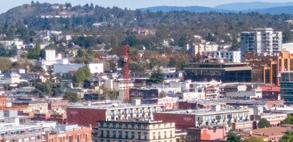






















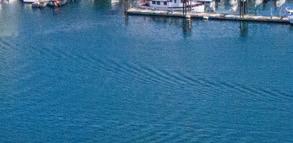






































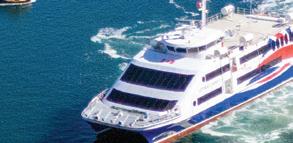






































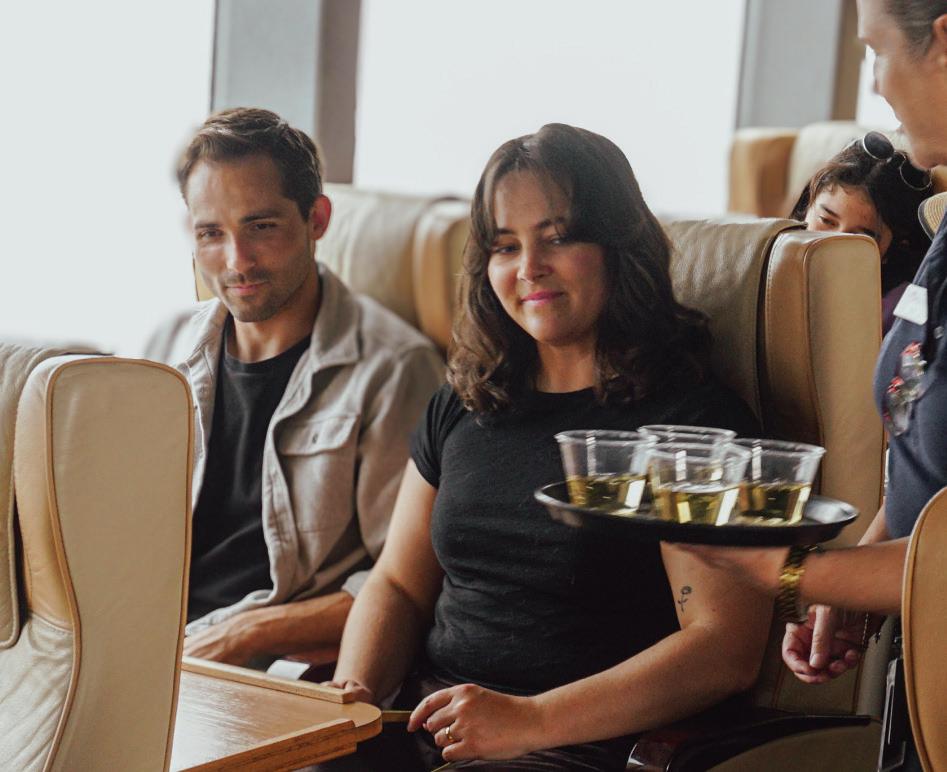








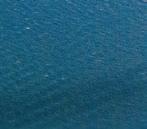







Old-world charm meets a modern pulse written by Ryn Pfeuffer
FROM SEATTLE’S hustle to Victoria’s graceful pace, the contrast is a welcome breath of fresh, salt-tinged air. This charming capital city on Vancouver Island, known as “The Garden City,” delivers old-world charm with a distinctly modern pulse. Getting there is half the fun: Hop aboard the Clipper Vacations ferry, with daily departures, and enjoy a scenic passage straight into Victoria’s storybook Inner Harbour.
Once you dock, everything shifts—your pace, perspective and even your palate. Start with a stroll along the waterfront. On a clear day, the Fairmont Empress shimmers like a palace from a children’s book. The Fairmont Gold suites offer sweeping harbor views and a lounge stocked with twenty-four-hour snacks. If you’re on a budget or just craving something funky, Hotel Zed, located just outside downtown, delivers a retro rainbow-hued vibe. Think neon flamingos, typewriters and a lobby equipped with rotary phones.
Victoria is where colonial history, First Nations heritage and contemporary cool come together. You’ll feel it as you head into Old Town, with its weathered brick buildings and timeworn beauty. Or as you paddle past waterfront buildings by kayak, the best way to take in the Inner Harbour’s breezy energy. Despite the floatplanes buzzing above and ferries gliding by, a guided paddle with Kelp Reef Adventures offers a peaceful perspective. Harbor seals laze on the docks, river otters twist through the water and, if you’re lucky, bald eagles soar overhead.
Destination BC/Reuben Krabbe
Victoria is where colonial history, First Nations heritage and contemporary cool come together. You’ll feel it as you head into Old Town, with its weathered brick buildings and timeworn beauty. Or as you paddle past waterfront buildings by kayak, the best way to take in the Inner Harbour’s breezy energy.




Back on land, hop on an e-bike and follow one of the region’s “flavor trails.” The Lochside Regional Trail, a flat and scenic 18-mile stretch running north toward Swartz Bay, winds past family-run farms, cideries and quirky roadside stands. Pick strawberries at Galey Farms or detour to Babe’s Honey Farm to try a fizzy Sparkling Bee Line, a kombucha-meets-mead-style drink made from fermented honey. Want to keep things closer to town? The Pedaler Cycling Tours & Rentals organizes a breezy Hoppy Hour tour that combines gentle cycling with tastings at Victoria’s top craft breweries. The floral-focused Pedal to the Petals ride, meanwhile, takes you through lush public and private gardens that earn the city its “Garden City” nickname. Between these active adventures, carve out time for one of Victoria’s most historic neighborhoods. Make your way to Fisgard Street, the heart of Canada’s oldest Chinatown, and pass through the Gate of Harmonious Interest. It’s a portal to the past—and a most tasty present. At Don Mee, brass carts deliver traditional dim sum; the shrimp dumplings are a standout. Nearby, Wah Lai Yuen Bakery turns out sweet-and-savory
EAT
Don Mee www.donmee.com
Dumpling Drop www.dumplingdrop.ca
Wah Lai Yuen Bakery + Restaurant www.facebook.com/ wlyvictoriabc
Fairmont Empress www.fairmont.com/en/hotels/ victoria/fairmont-empress.html
Hotel Zed www.hotelzed.com/victoria
Babe’s Honey Farm www.babes-honey-farm.com
Galey Farms www.galeyfarms.ca
Kelp Reef Adventures www.kelpreef.com
Lochside Regional Trail www.crd.ca/parks-recreation/ find-park-or-trail/lochsideregional-trail
The Pedaler Cycling Tours & Rentals www.thepedaler.ca
Victoria Chinatown Museum www.victoriachinatown museum.com
cocktail buns. Loy Sing’s gleaming barbecue pork deserves a spot on your table (or eaten straight from the takeout box). (Fun fact: Loy Sing holds the title of the longest continually run Chinese business in North America. It has now been in operation for 136 years and counting.)
Wander over to Fan Tan Alley, Canada’s narrowest street, once home to gambling dens and opium parlors during the gold rush. Today, it’s lined with eclectic boutiques and a few unexpected gems, like the Dumpling Drop, a favorite for deep-fried dumplings filled with pork belly or lemongrass chicken. Next door, the Victoria Chinatown Museum provides powerful context, with exhibits that trace the hopes, struggles and contributions of early Chinese immigrants. Compact but impactful, it grounds your visit in history that’s easy to overlook but impossible to forget.
In a city where you can spot whales in the morning, pedal through farmland by afternoon and finish with dumplings in a nineteenth-century alleyway, the only thing you’ll want more of during a weekend in Victoria, B.C., is time.

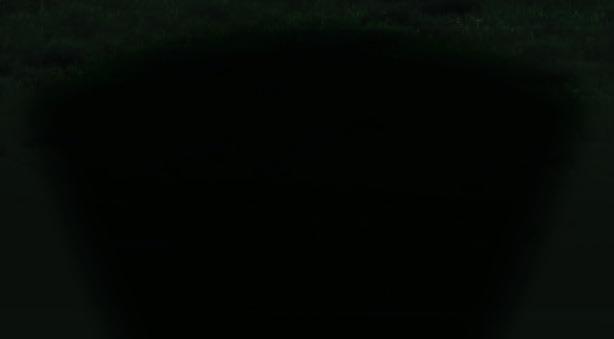














Midweek
























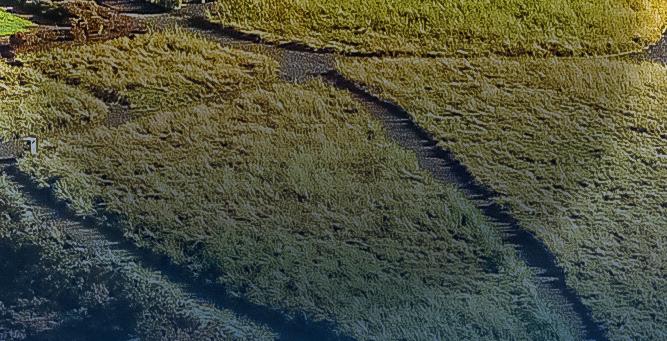
























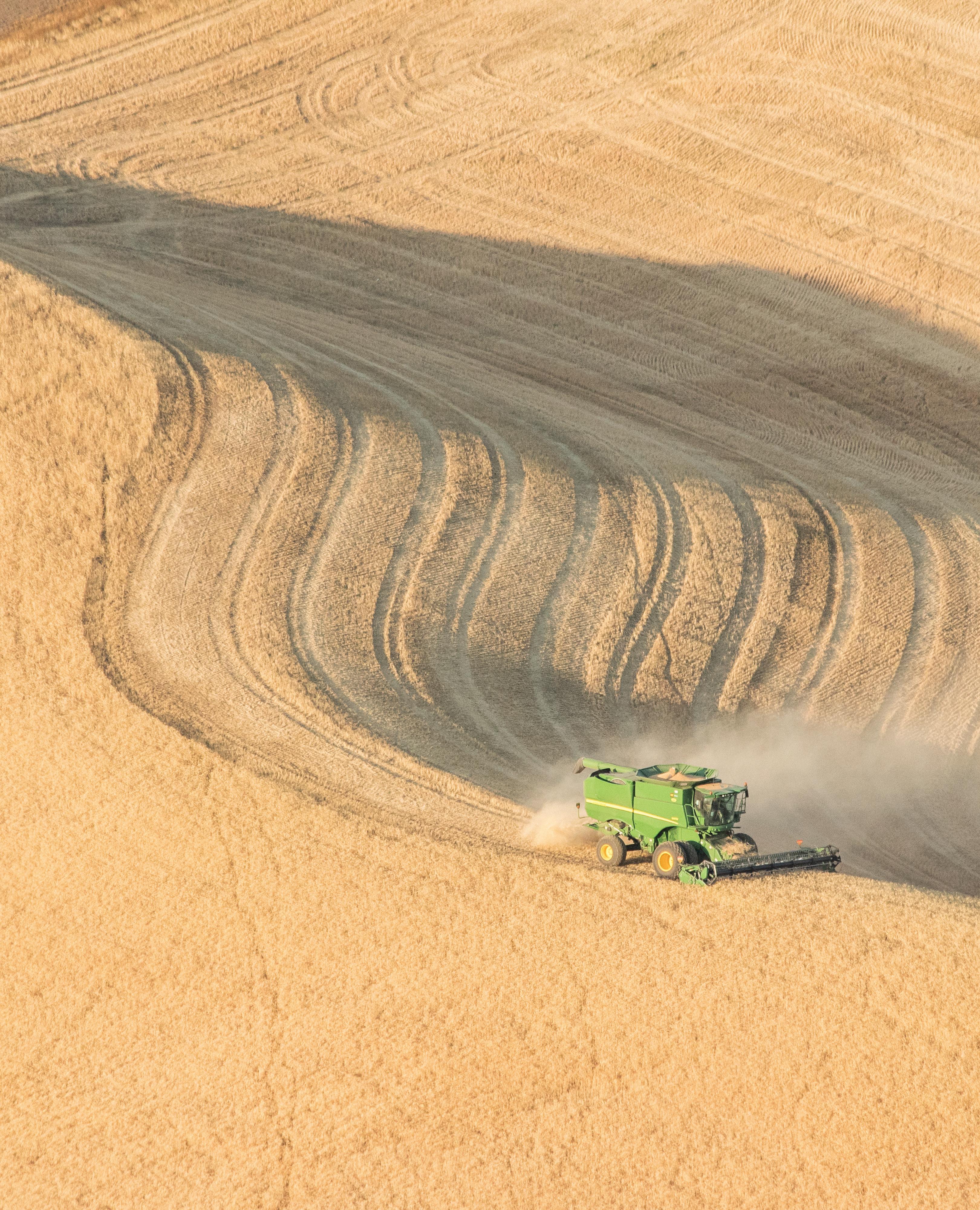

fields
August harvest in motion—a combine rolls through the





Sip the world’s best wines & learn about how winemakers are handling climate change
























































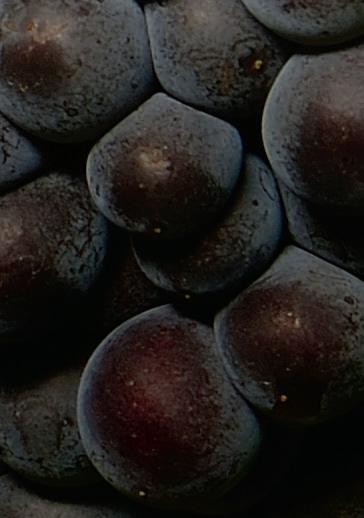





At a winery in the Pacific Northwest, a woman swirls pinot noir in her glass. She puts her nose into the glass and inhales to take in the bouquet of the 2022 vintage and looks out over the vineyard from where this block of wine grapes came. “I’m getting notes of blackberry, chocolate and …” She cocks her head to one side
as if this thought is coming from a different part of her brain: “… ponderosa pine char.” e effects of climate change and global warming are challenging the wine industry in the Pacific Northwest to innovate or die on the vine. One need only look back to the devastation in and around Napa Valley over the past decade to see that the times they are a changin’. In the Camp Fire, the heart of California wine
country lost eighty-five people, 11,000 homes and 153,000 acres. ese fires are a symptom of a larger problem that has been acknowledged and growing for decades. Back in 1992, the writing was already on the wall for the long-term sustainability of the animal population, oceans, agriculture and people. Written by Henry Way Kendall, an MIT particle physics professor and Nobel Prize winner, World
Scientists’ Warning to Humanity began like this: “Human beings and the natural world are on a collision course. Human activities inflict harsh and often irreversible damage on the environment and on critical resources. If not checked, many of our current practices put at serious risk the future that we wish for human society and the plant and animal kingdoms, and may so alter the living world


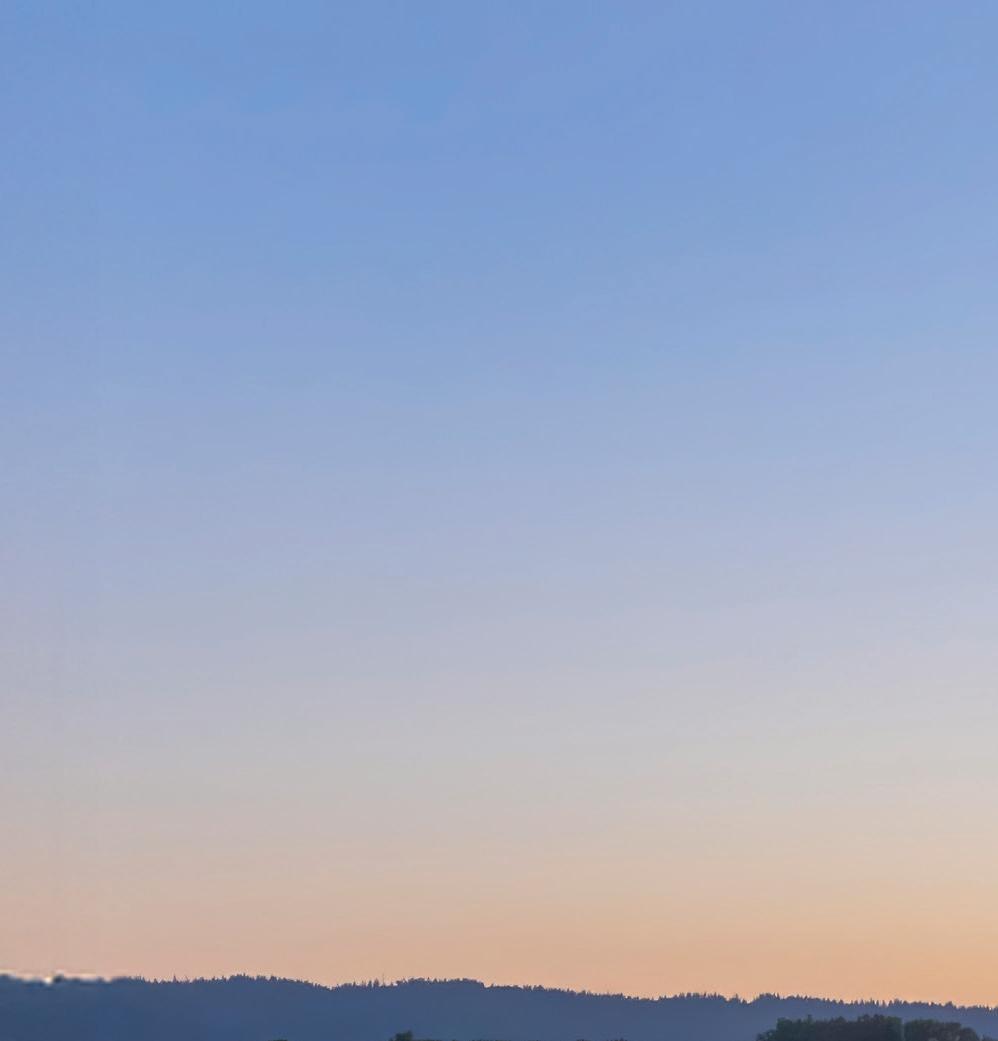



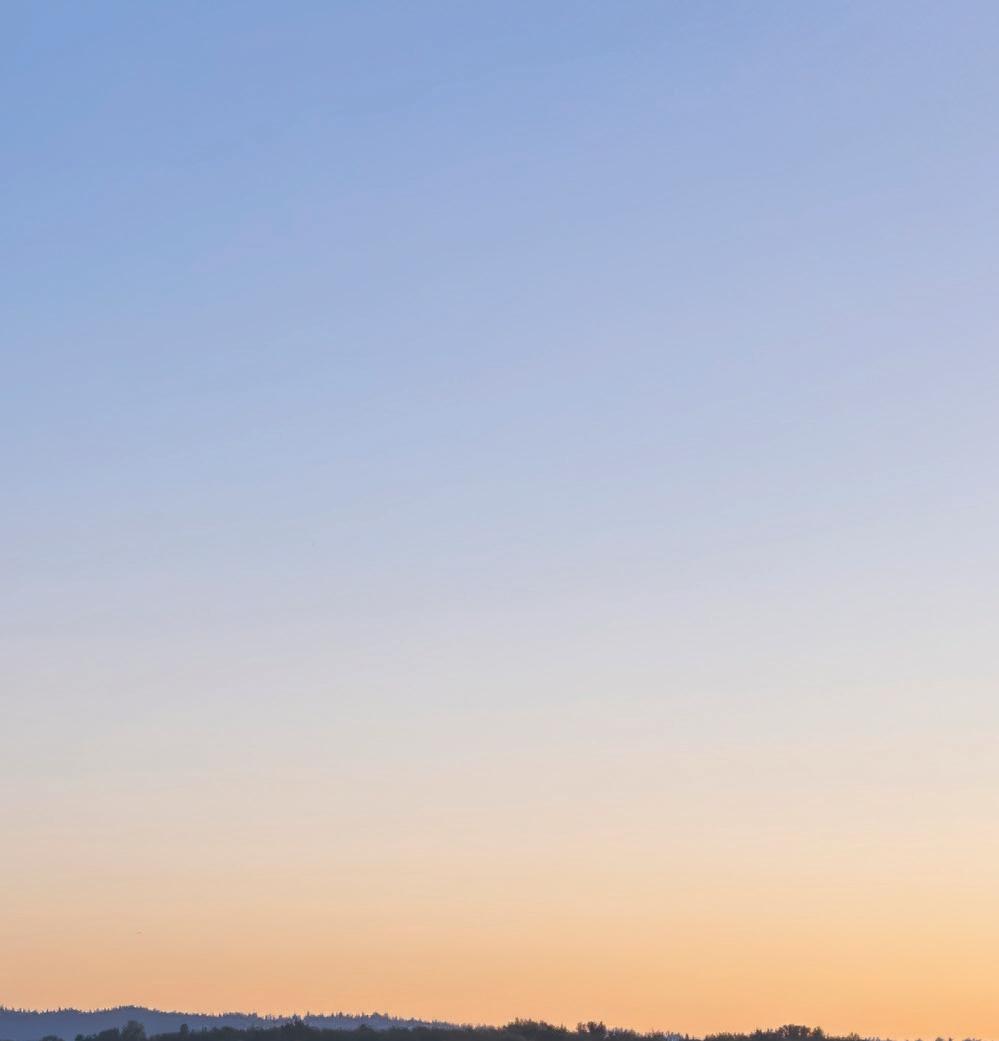







that it will be unable to sustain life in the manner that we know. Fundamental changes are urgent if we are to avoid the collision our present course will bring about.” It was signed by 1,700 of the world’s leading scientists.
In 2017, feeling like they weren’t sufficiently heard, scientists issued a second warning, this one written by Oregon State ecology professor William Ripple and signed by 15,364 scientists.
So what’s at stake right now for the wine industry in the Pacific Northwest? Between Washington and Oregon, it’s a massive industry with a significant contribution to their economies.
Next to California, Washington and Oregon are the next biggest wine-growing regions in the
United States. Washington has approximately 1,050 wineries over 50,000 acres accounting and $10.5 billion in economic impact. Across the Columbia, Oregon’s wine industry accounts for more than 1,150 wineries, nearly 46,000 acres of vineyards and more than $8 billion annual economic impact.
The industry is facing a multitude of issues related to climate change. Warmer temperatures are leading to quicker ripening of grapes, before the compounds that give wine grapes their aroma and taste have time to catch up. Drought and water conservation are a compound-
ing factor with warmer temperatures. These conditions also lead to increased wildfires in the Pacific Northwest, which can present itself in the taste of wine grown in the fire region. “Is this the Camp Fire vintage?” Add in a dose of increasing extreme weather events and you have the climate challenge that our wine industry faces today.
The industry is also facing new challenges not related to climate, but from defunding science. In February, thousands of federal workers across several agencies were fired as part of the Trump administration’s broad effort to reduce the federal government’s workforce, according to Oregon Public Broadcasting. That includes at least nineteen U.S. Depart-
ment of Agriculture research and administrative employees, including many who worked in collaboration with OSU at the university’s agricultural research stations.
For the hardworking people in the wine industry, this is their family business, their legacy, their passion. Failure is not an option. Innovation is de rigueur.
At one vineyard on the border of Oregon and Washington, a pilot project holds promise for the industry far beyond the Northwest.
One of today’s biggest challenges “is to produce quality wines that reach balanced

Explore Oregon’s Wine Country through our website.
The industry is facing a multitude of issues related to climate change. Warmer temperatures are leading to quicker ripening of grapes, before the compounds that give wine grapes their aroma and taste have time to catch up. Drought and water conservation are a compounding factor with warmer temperatures. These conditions also lead to increased wildfires in the Pacific Northwest, which can present itself in the taste of wine grown in the fire region.
phenolic ripeness,” according to a February 2025 report in the Harvard Data Science Review “Because it is warmer, the sugar maturity of wines increases faster, and so the phenolic (aroma) properties of the wines are not sufficient.”
A project led by Oregon State University’s horticulture program uses natural kaolin clay (spray) to protect wine grapes from heat and sunburn, allowing grapes to ripen alongside their other bouquet qualities. is research found that blocks that were treated with the kaolin spray produced “greater yields and fruit quality compared to the control plot, where kaolin wasn’t applied. Evidence also showed that kaolin reduced the impact of heat and light on vine leaf function.”
Five years ago, wildfires did an estimated $3 billion in damage to the wine crop of 2020 in the Northwest and California. is big number called for further research and innovation. How can the sensitive skins


of grapes camp among these recurring natural catastrophes yet not smell like the campfire?
Yanyun Zhao, distinguished professor of Food Science and Technology from Oregon State University, and colleagues developed a spray coating that blocks the phenols that contribute to smoke-damaged grapes without impairing the growth or quality of the grapes. is product could be available to wine growers in the next couple of years.
Professor Zhao’s work to help save the multibillion-dollar industry from climate change, however, is funded by the Oregon Department of Agriculture and the U.S. Department of Agriculture, the latter in the process of being defunded. e only innovation to oppose defunding science is education and knowledge. e only solution for protecting our wine industry that produces some of the world’s greatest pinot noirs and cabernet sauvignon comes down to science.













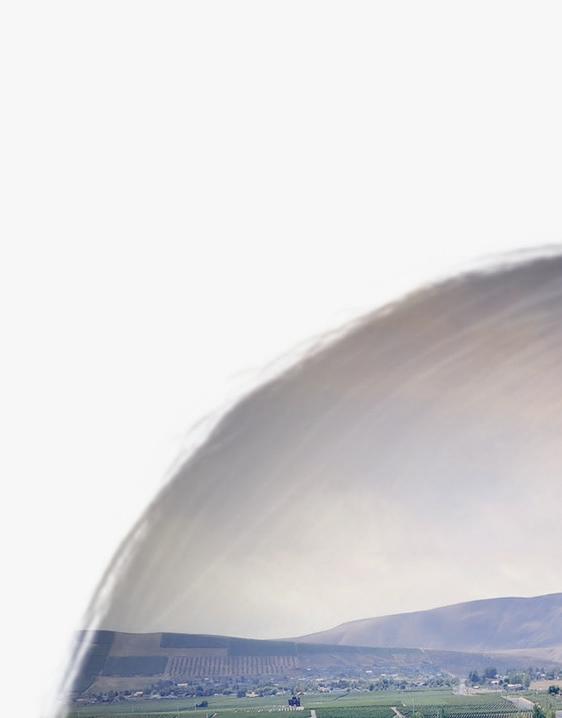























Unwind in the refreshing swell of life on the river. In the Heart of Washington Wine Country® relaxation flows across 200 wineries and vineyards – all within a 50-mile radius. Here, tasting is only part of the experience. Well-blended vacations include unlimited sunshine, award-winning blends, a captivating fusion of history and science, open skies, and endless space. Visit DISCOVER WHAT’S IN YOU. the Tri-Cities and














